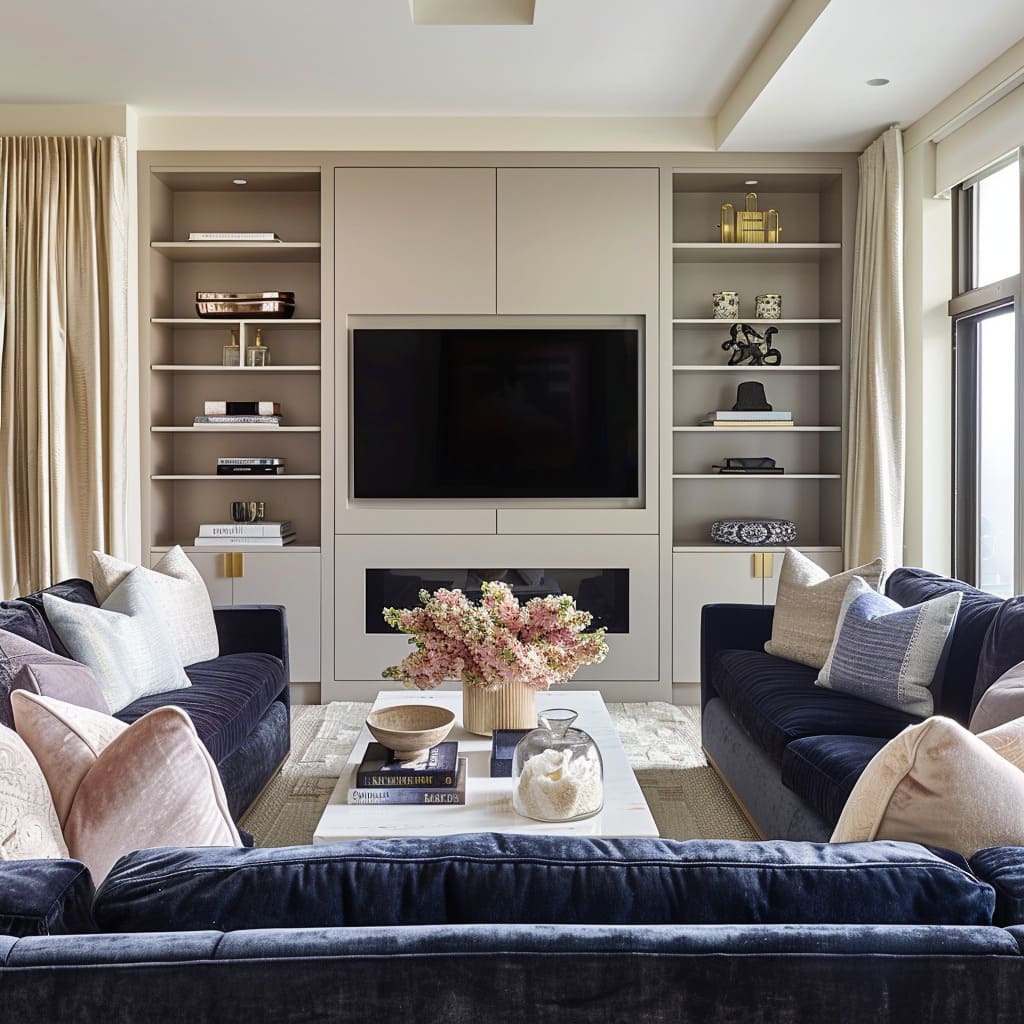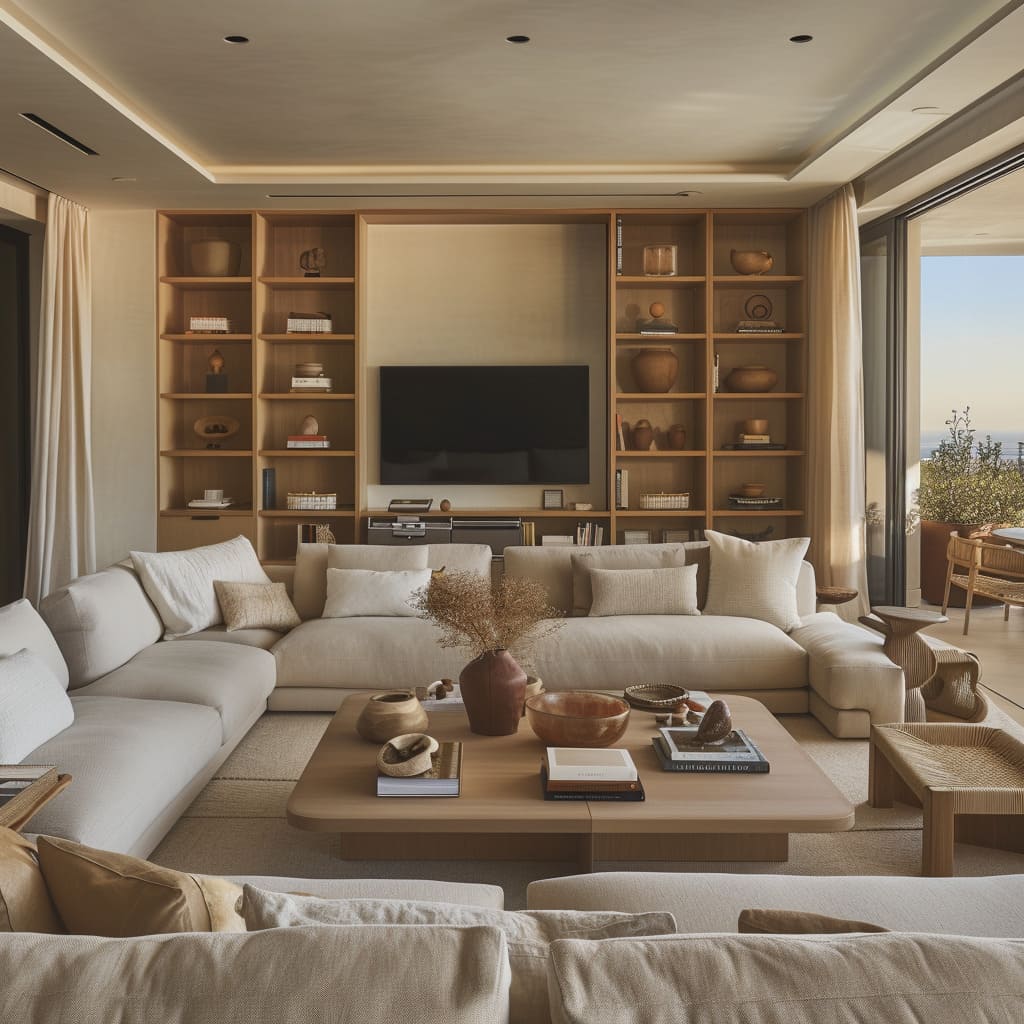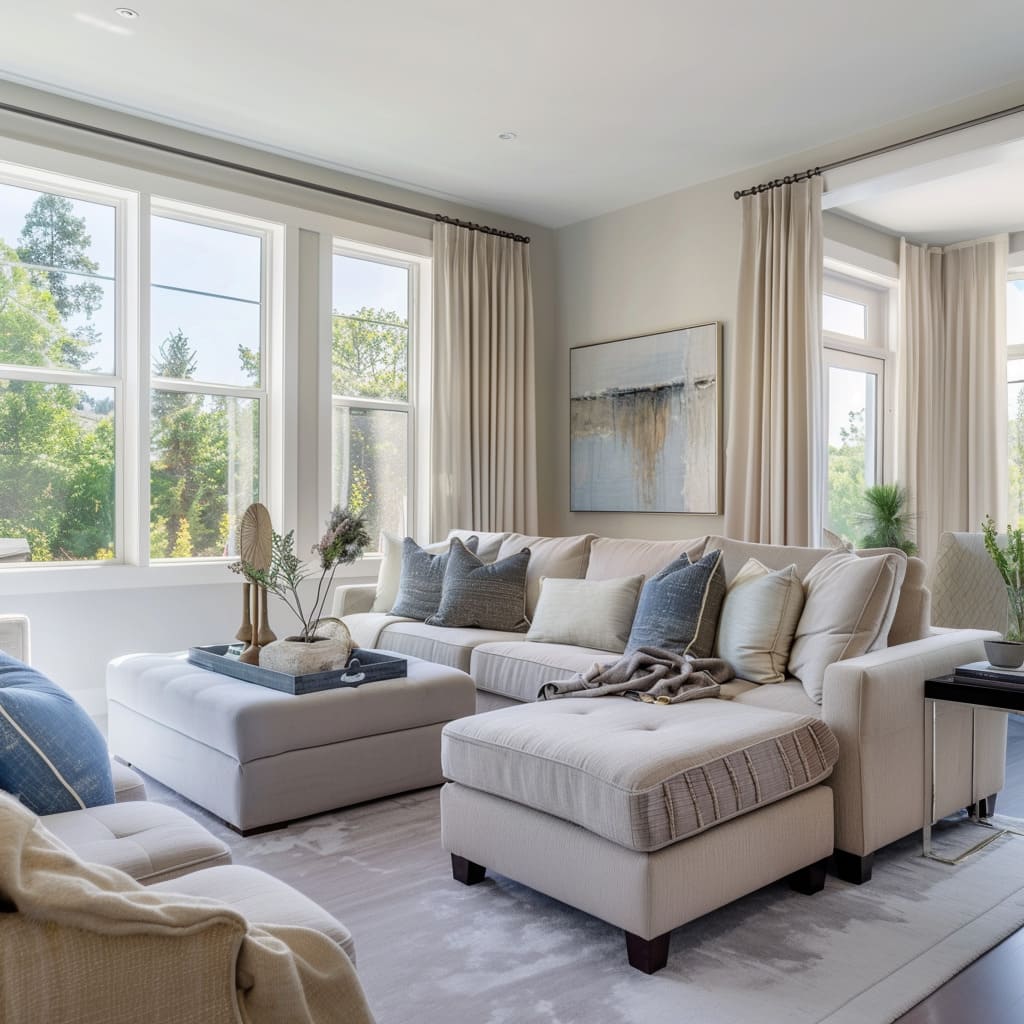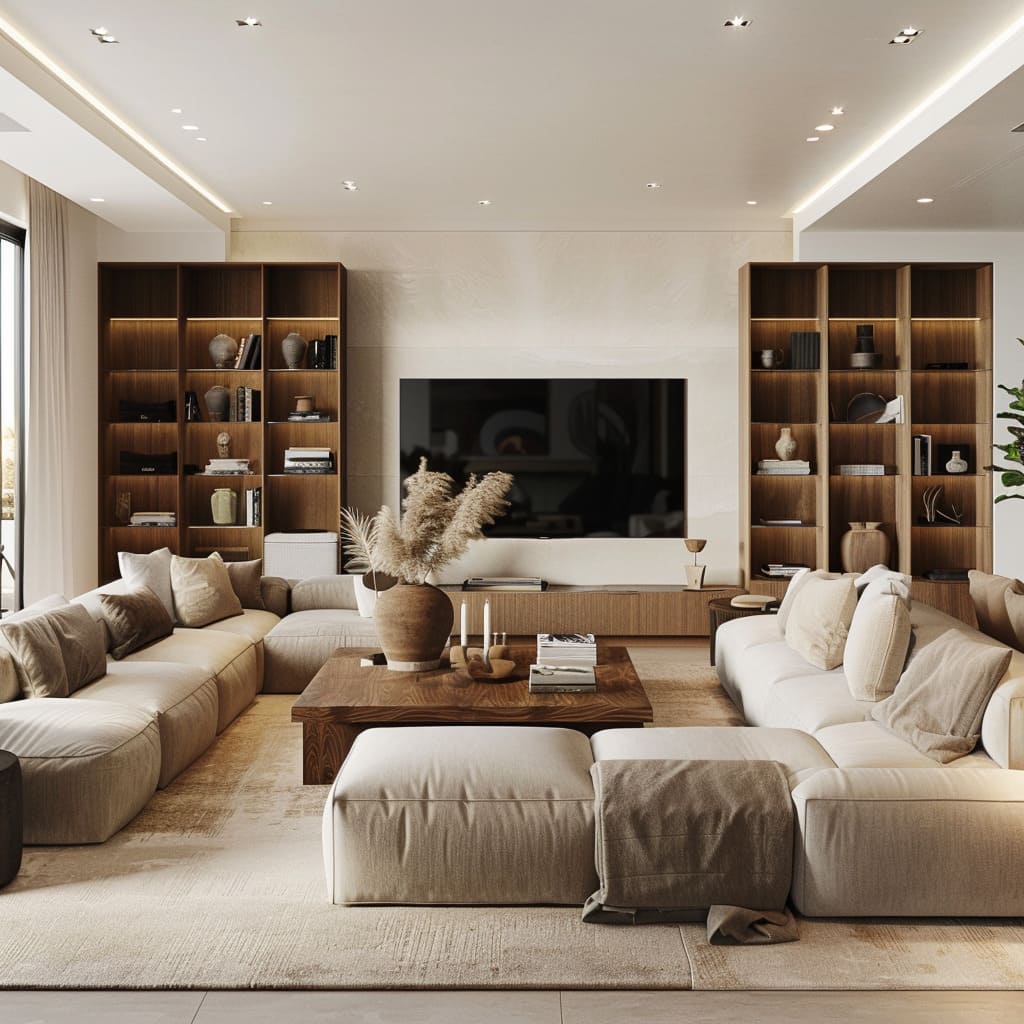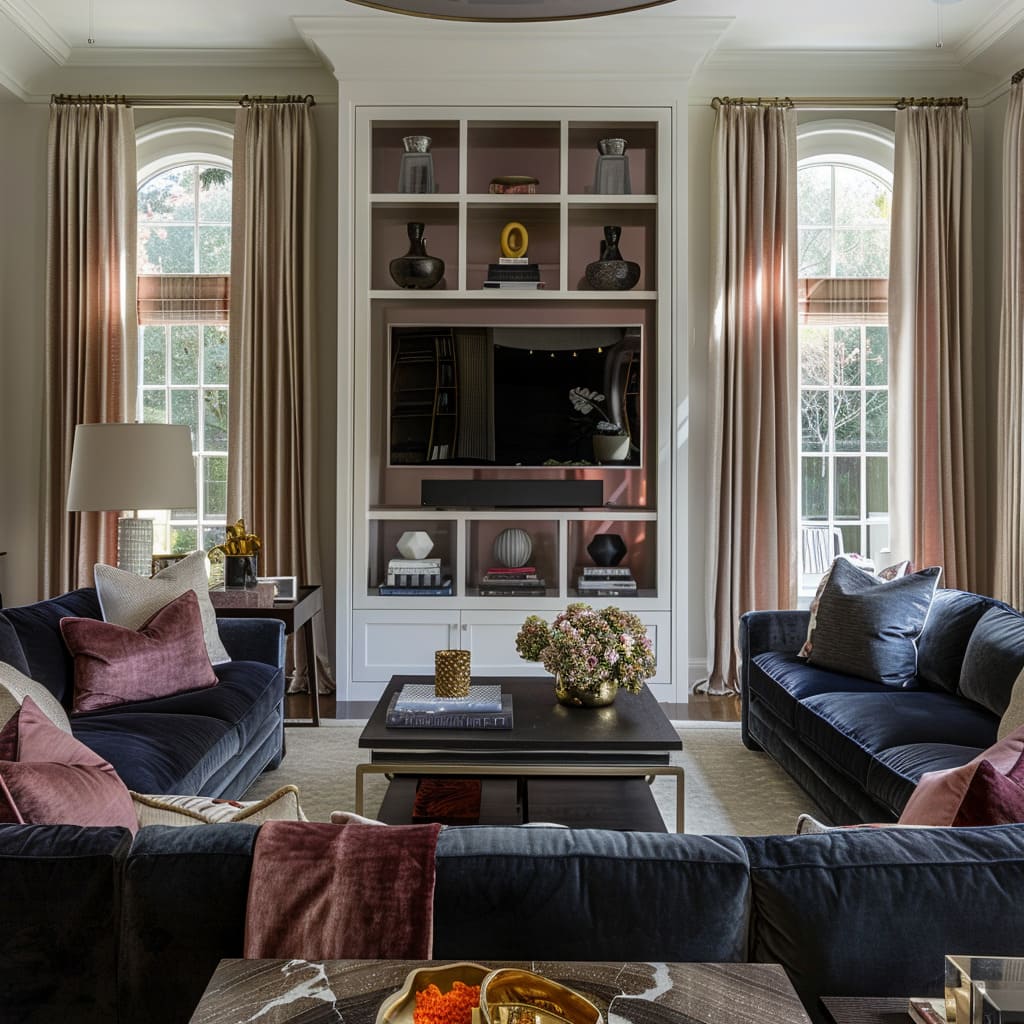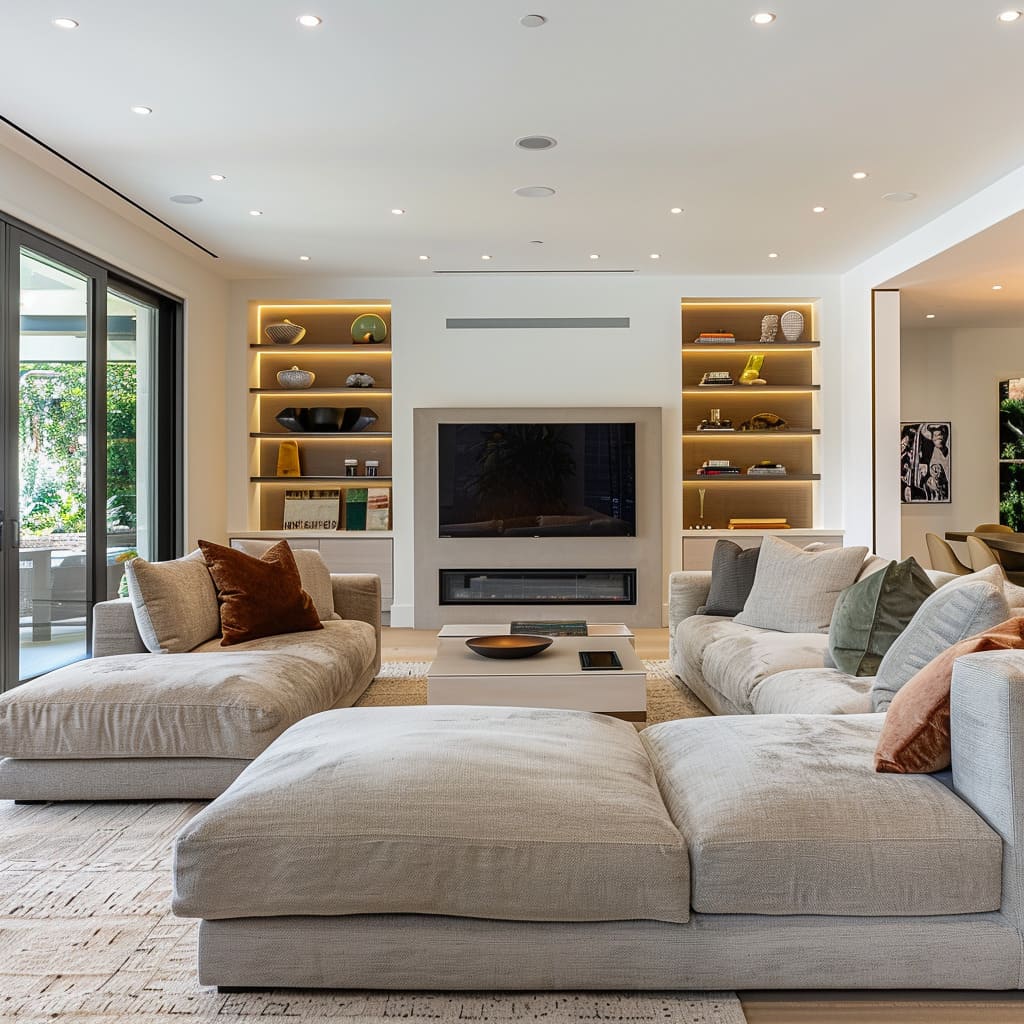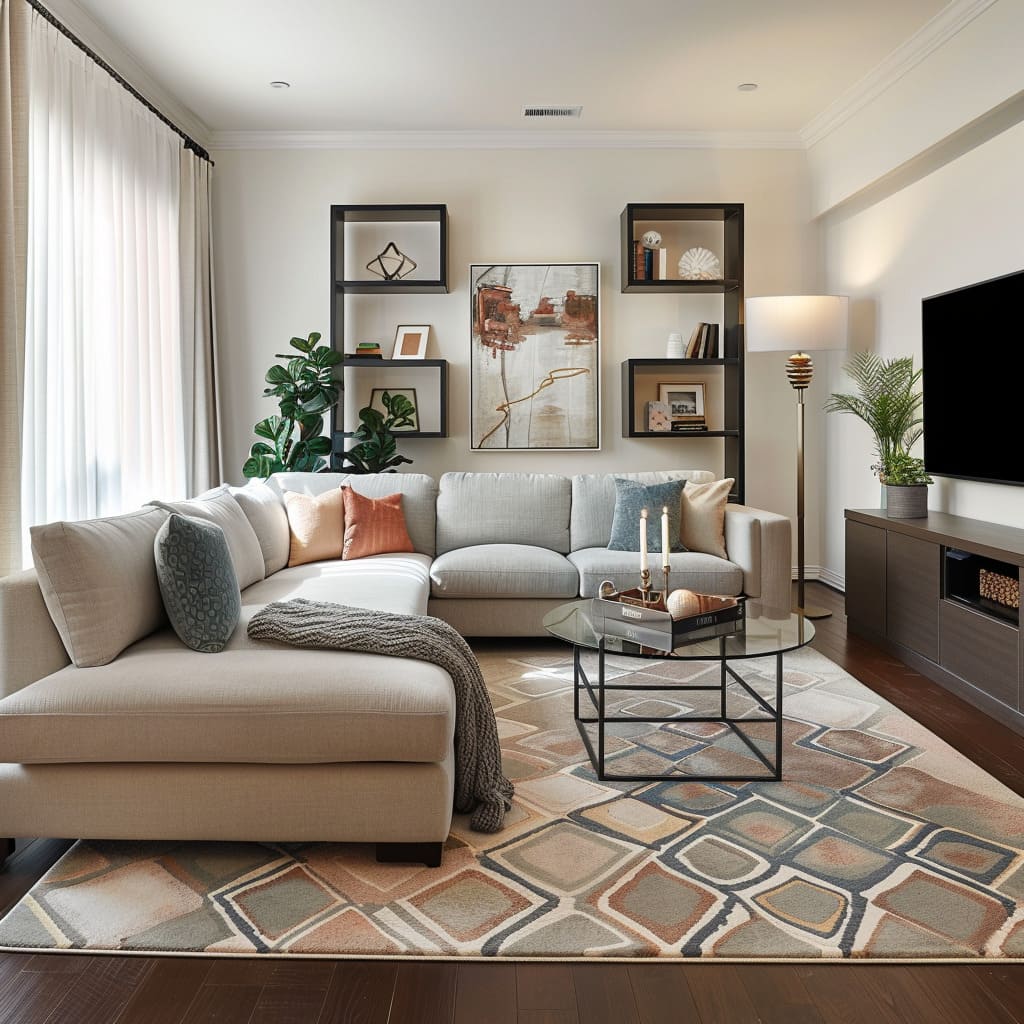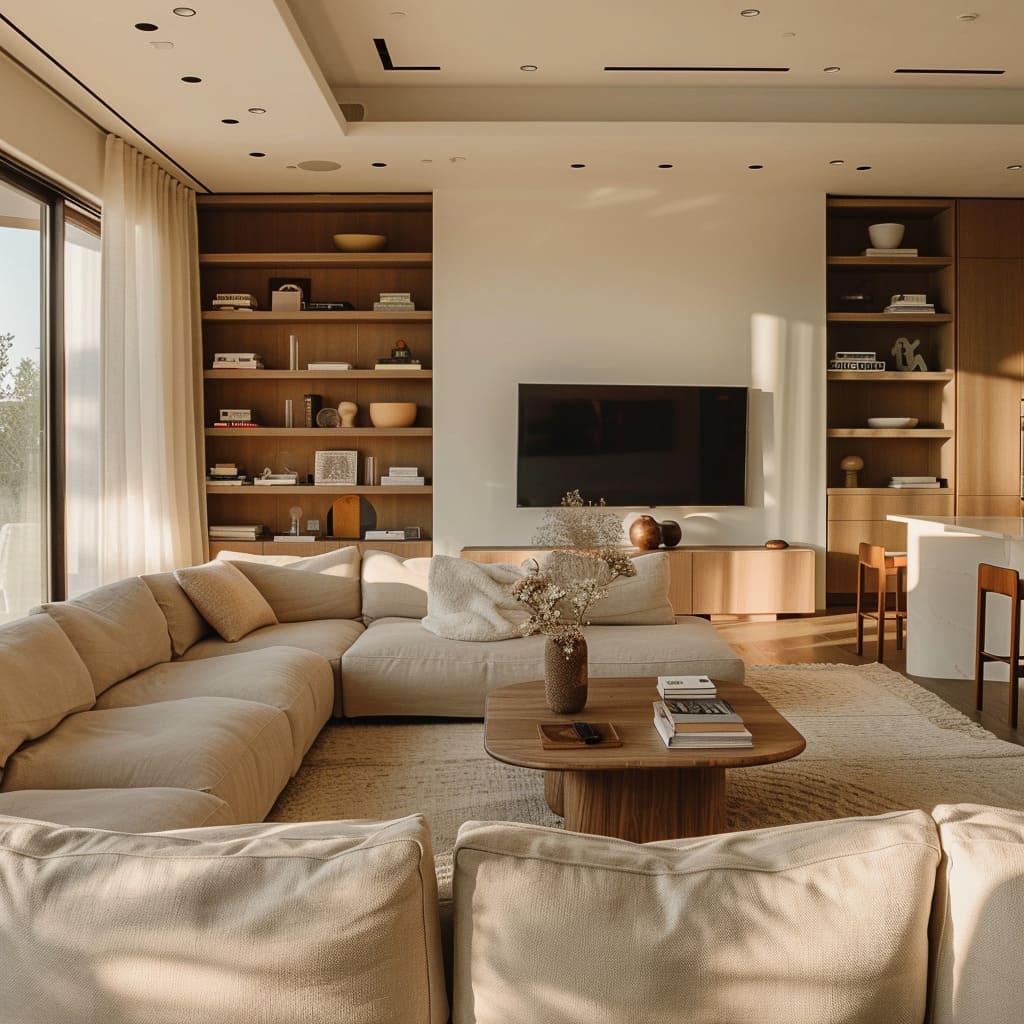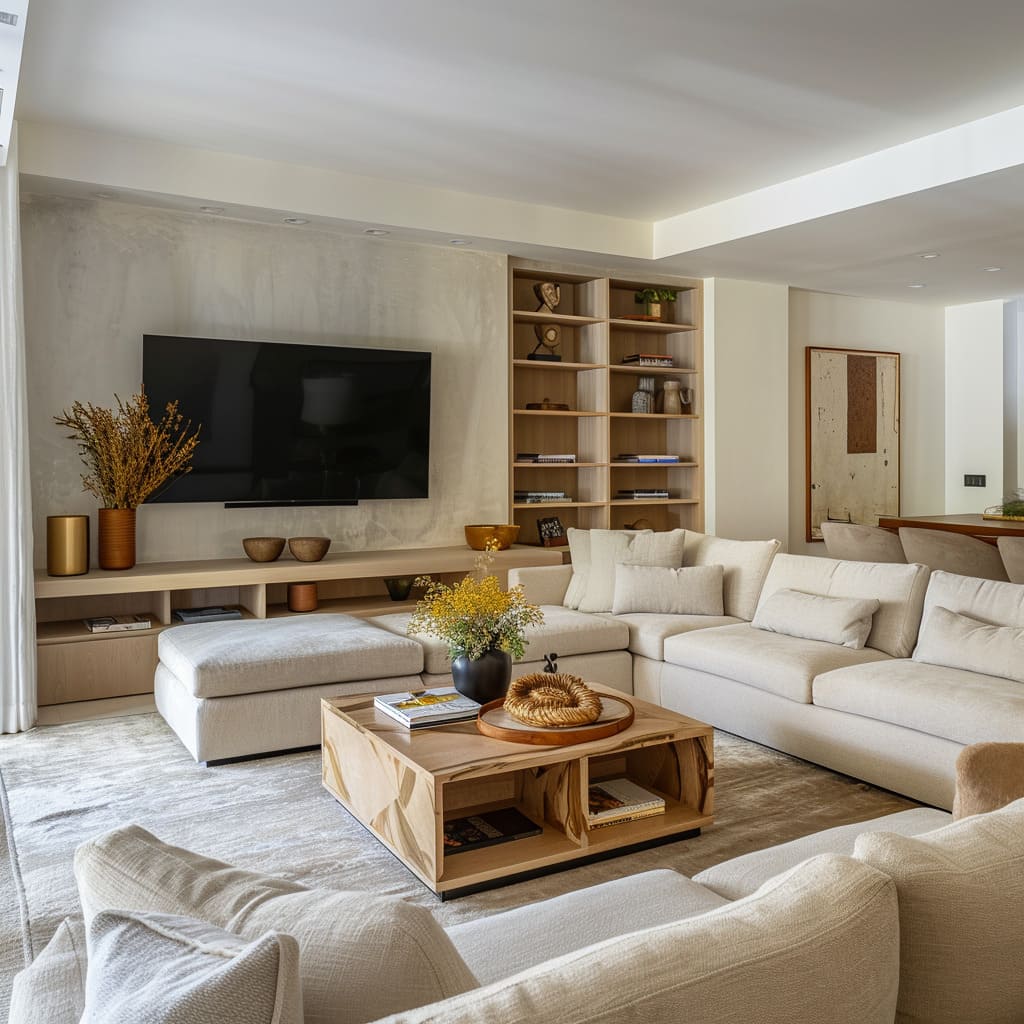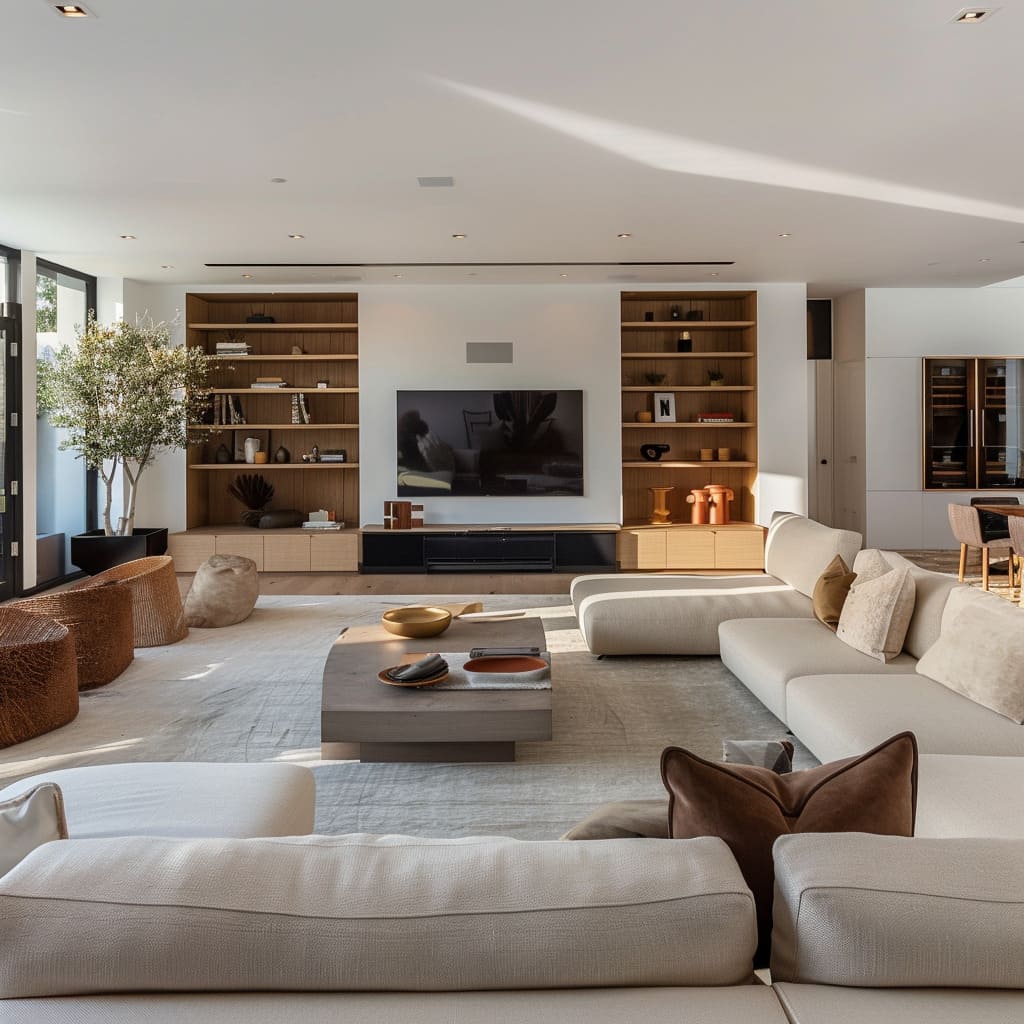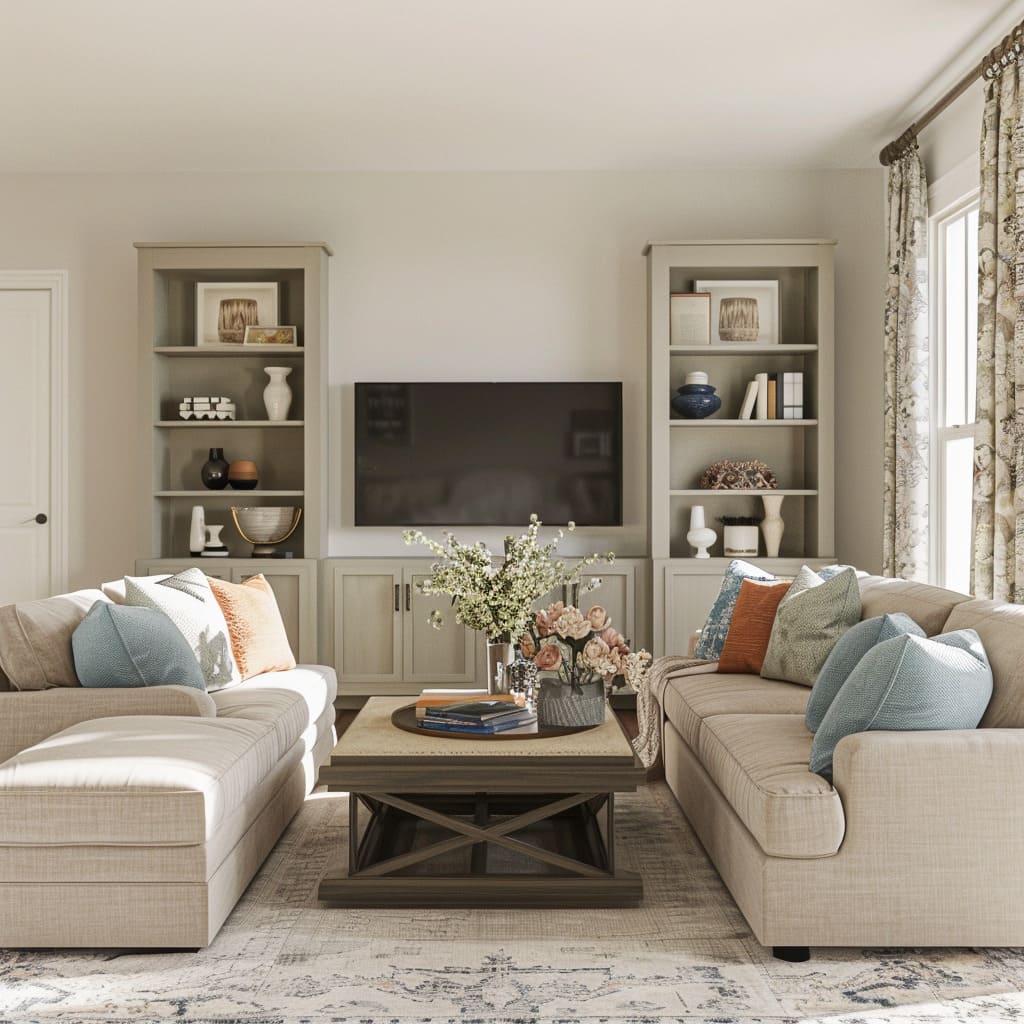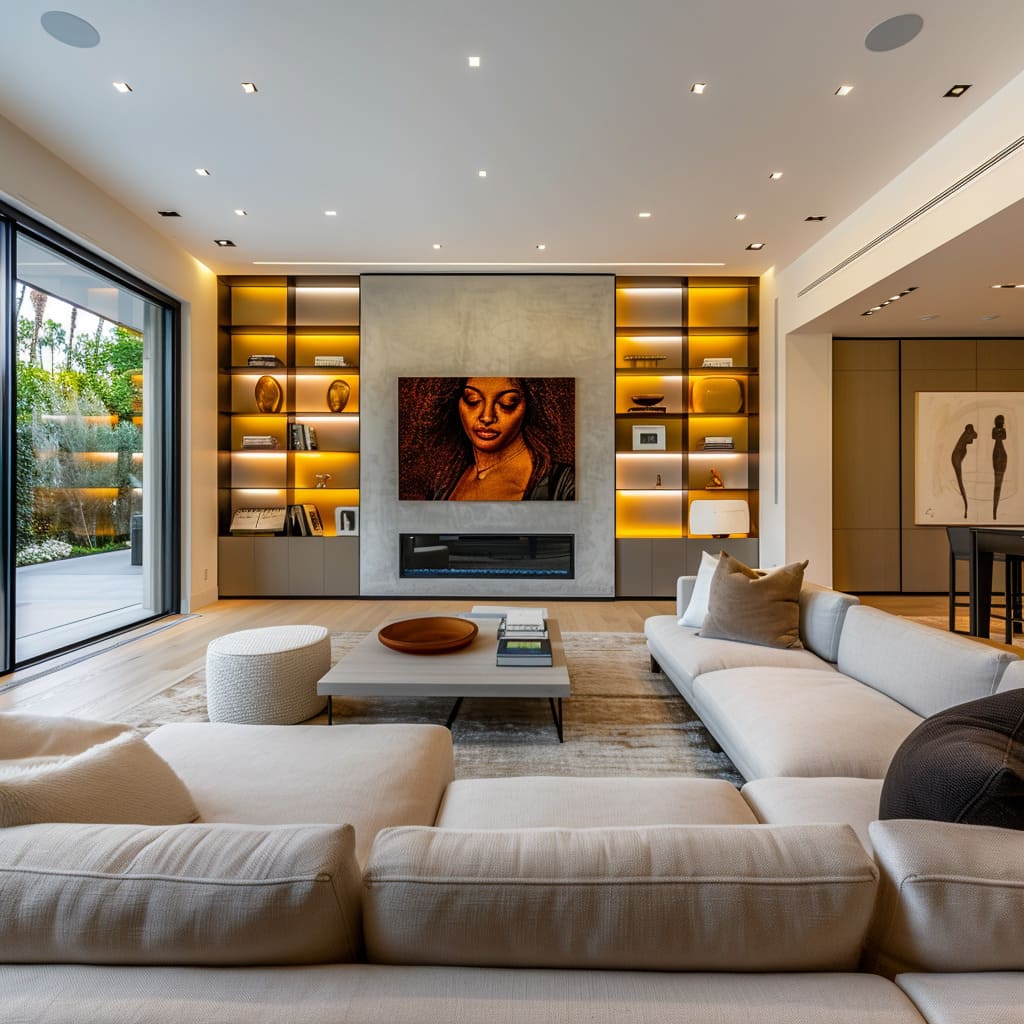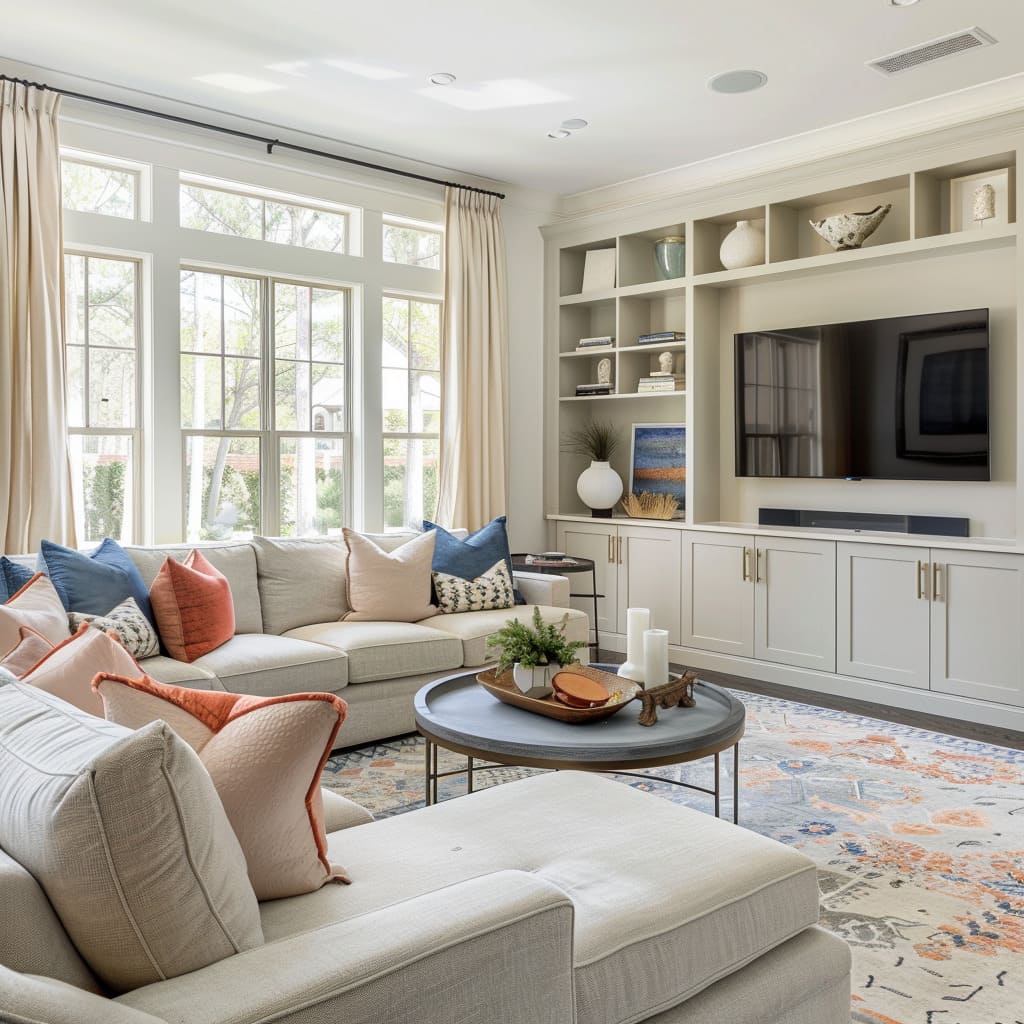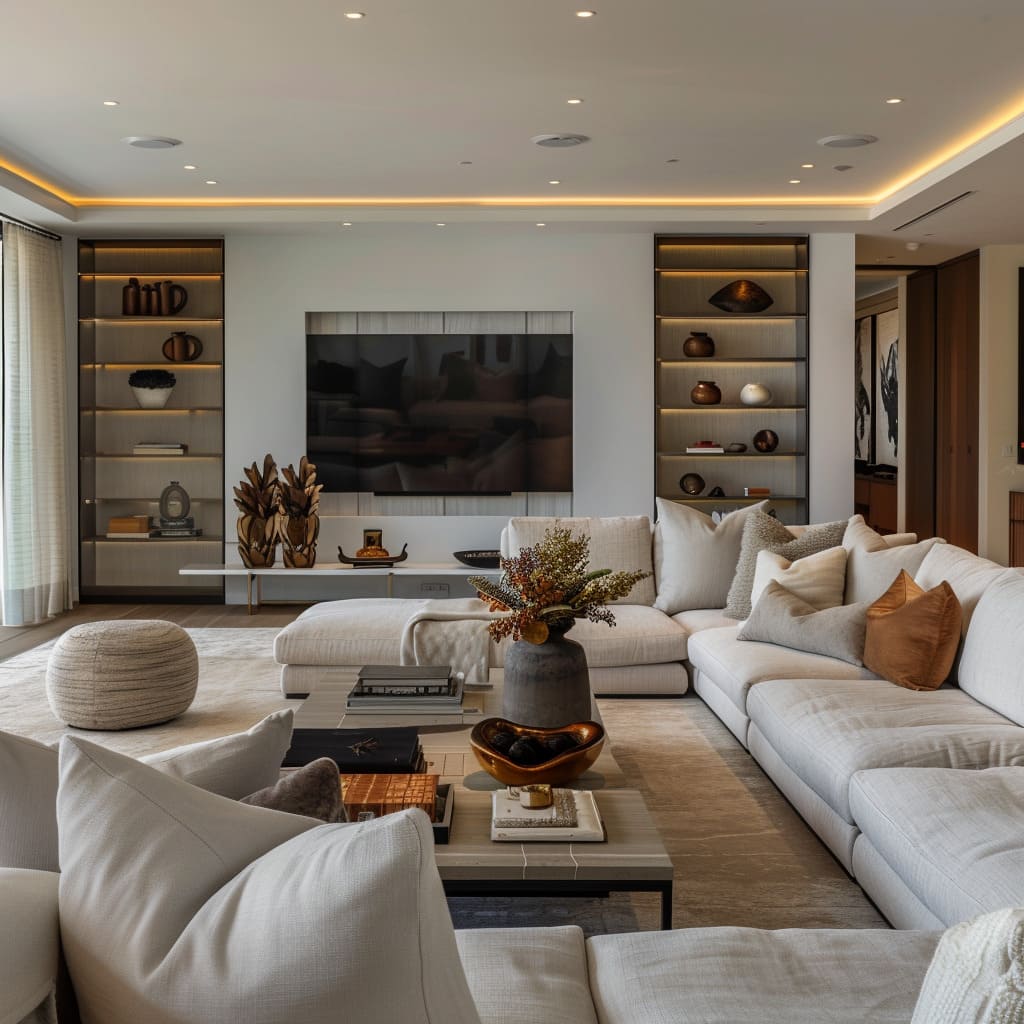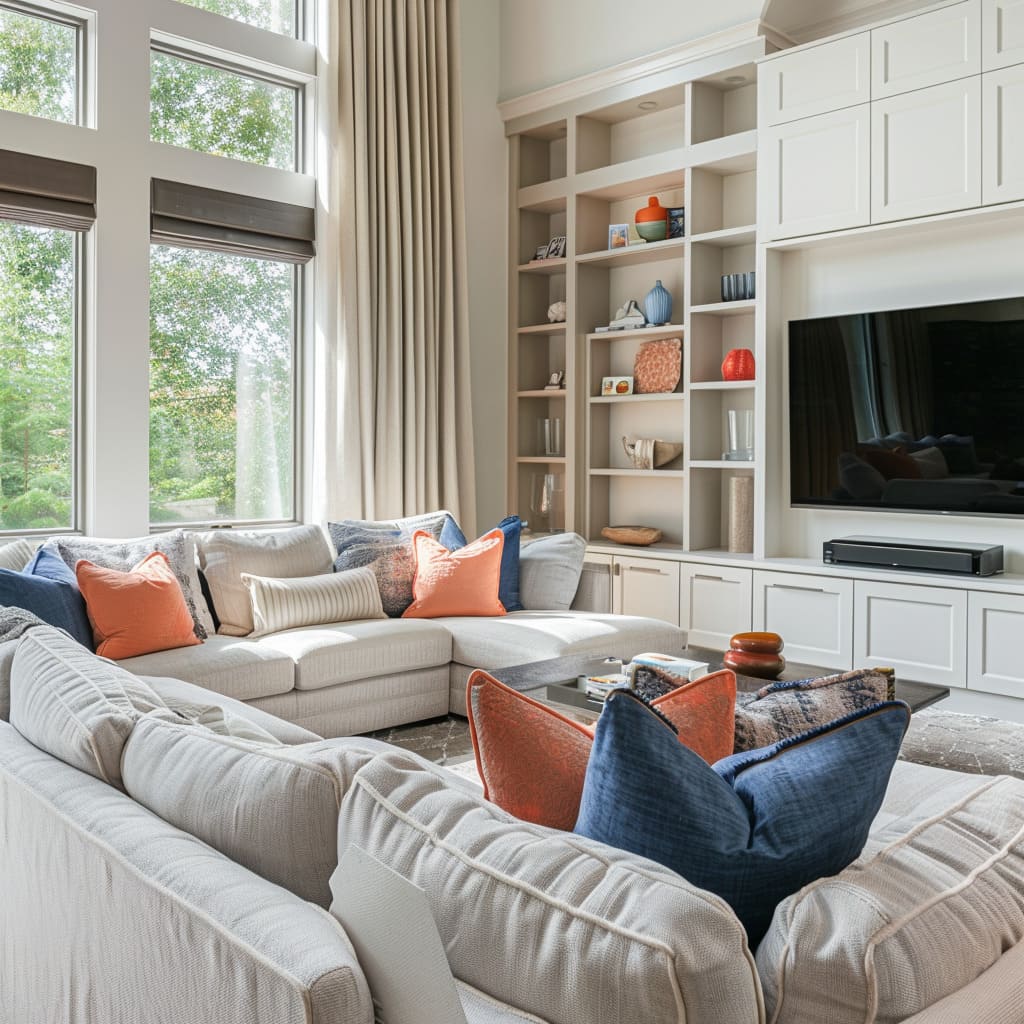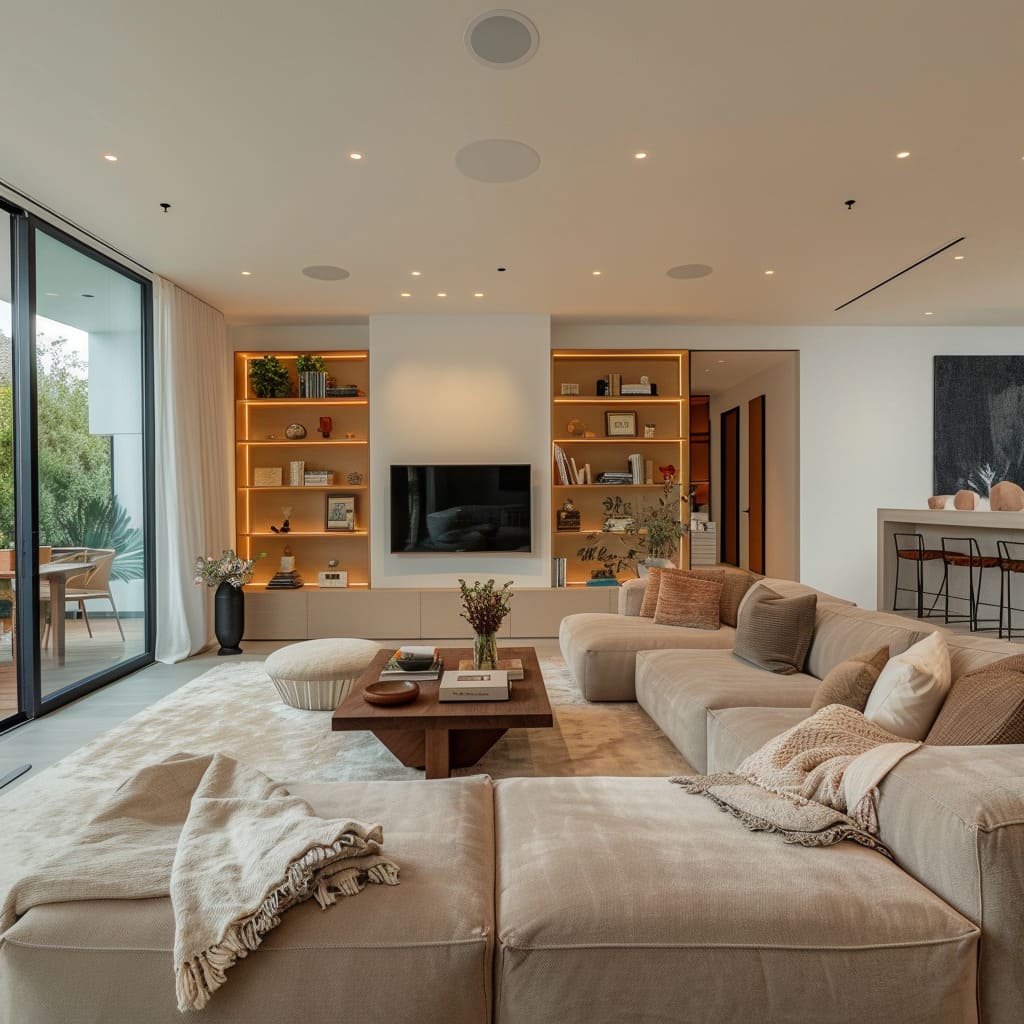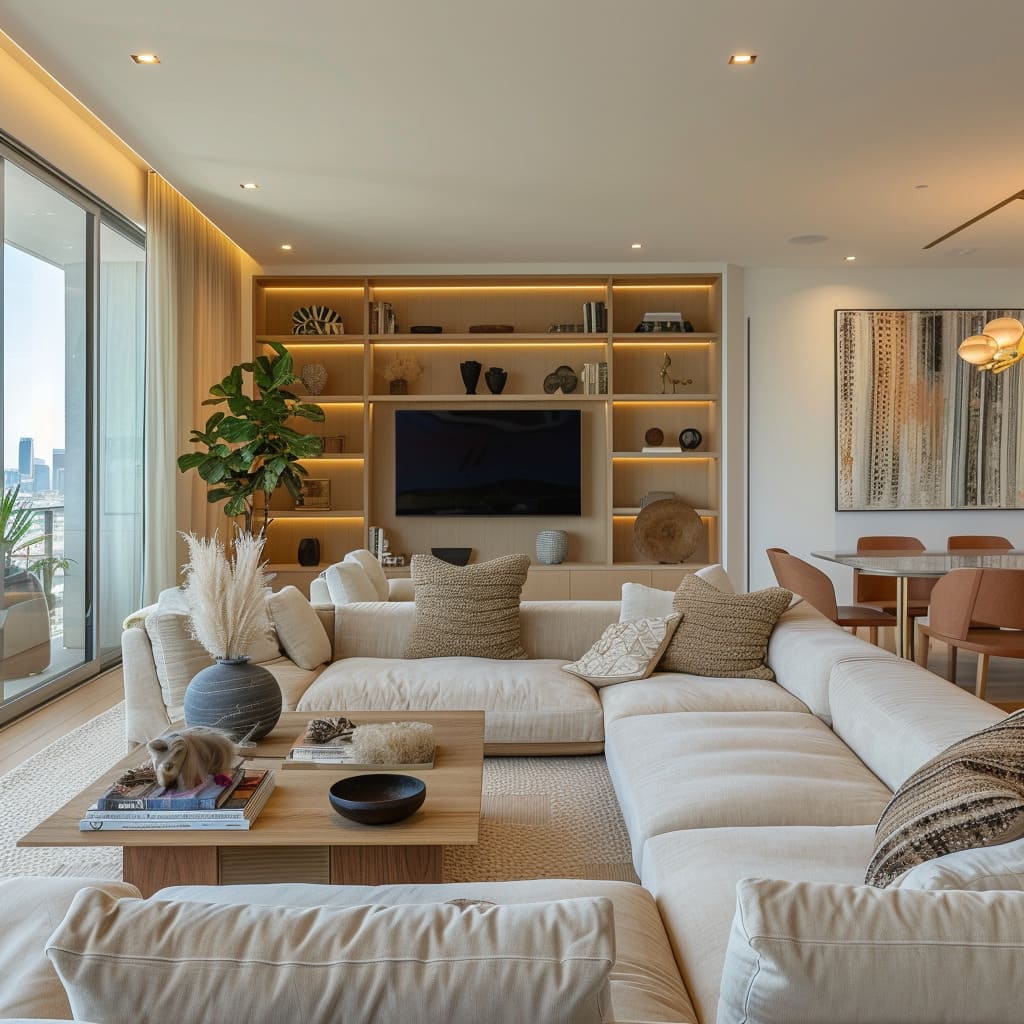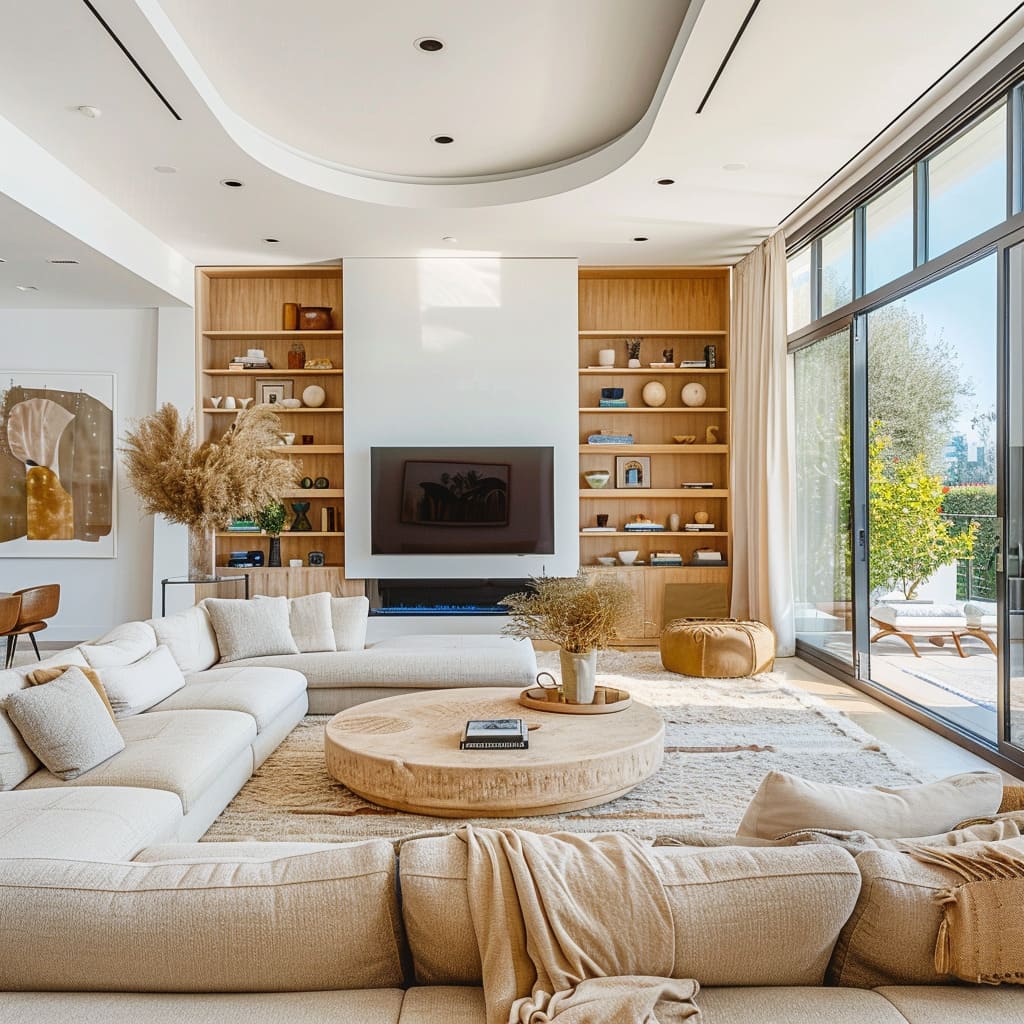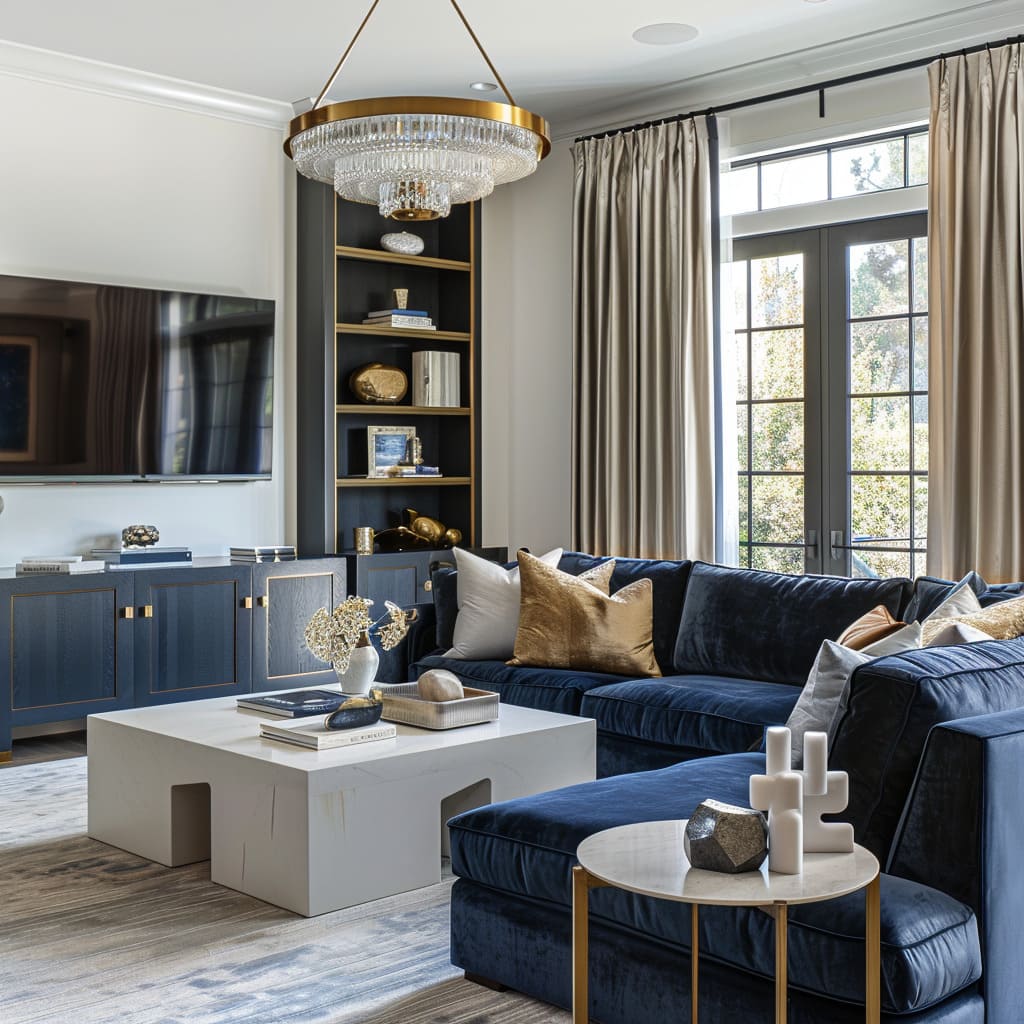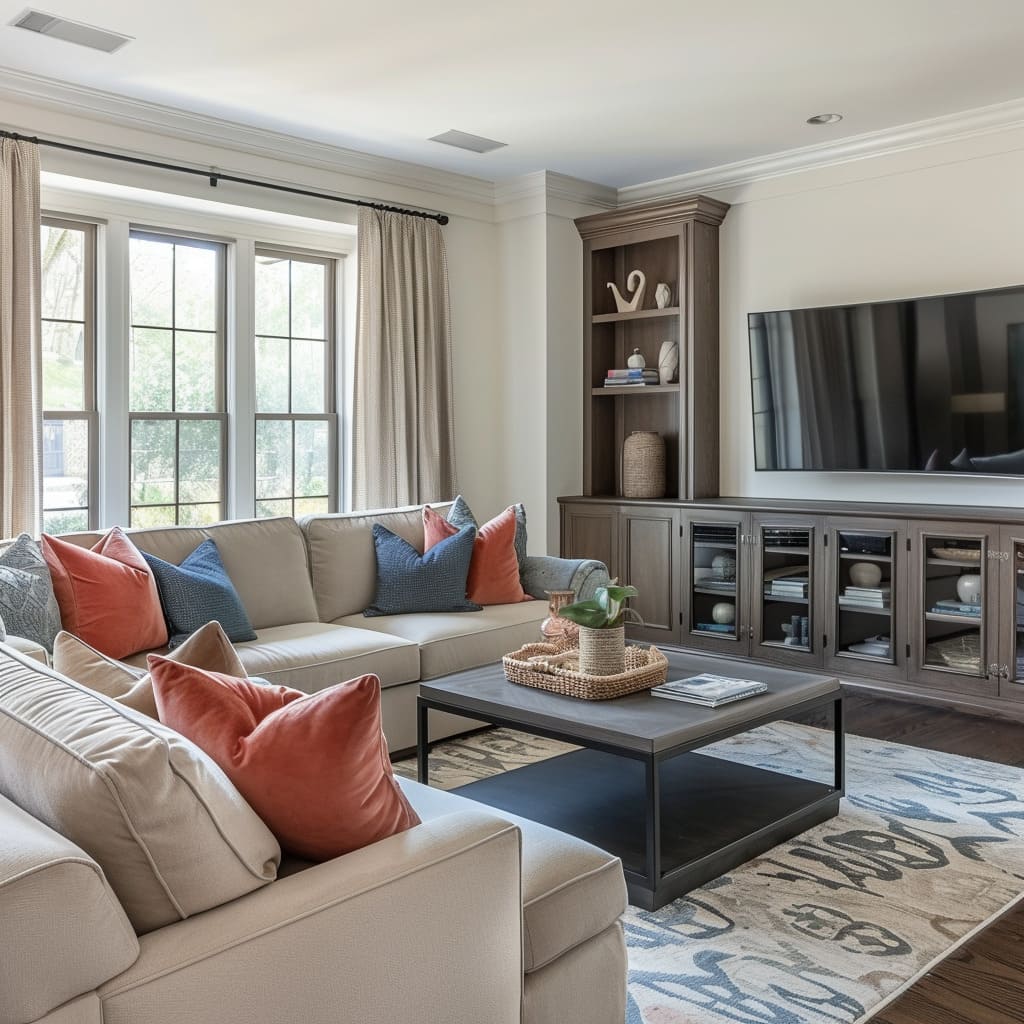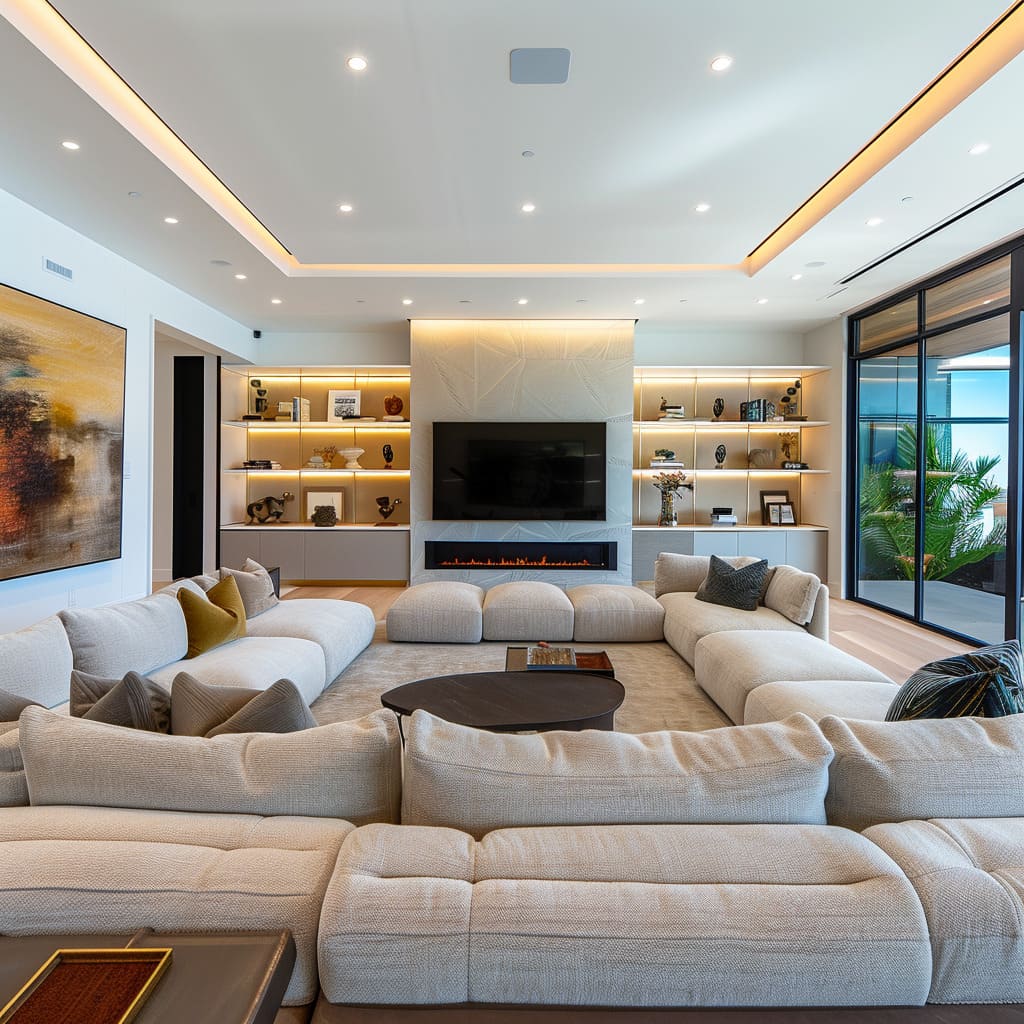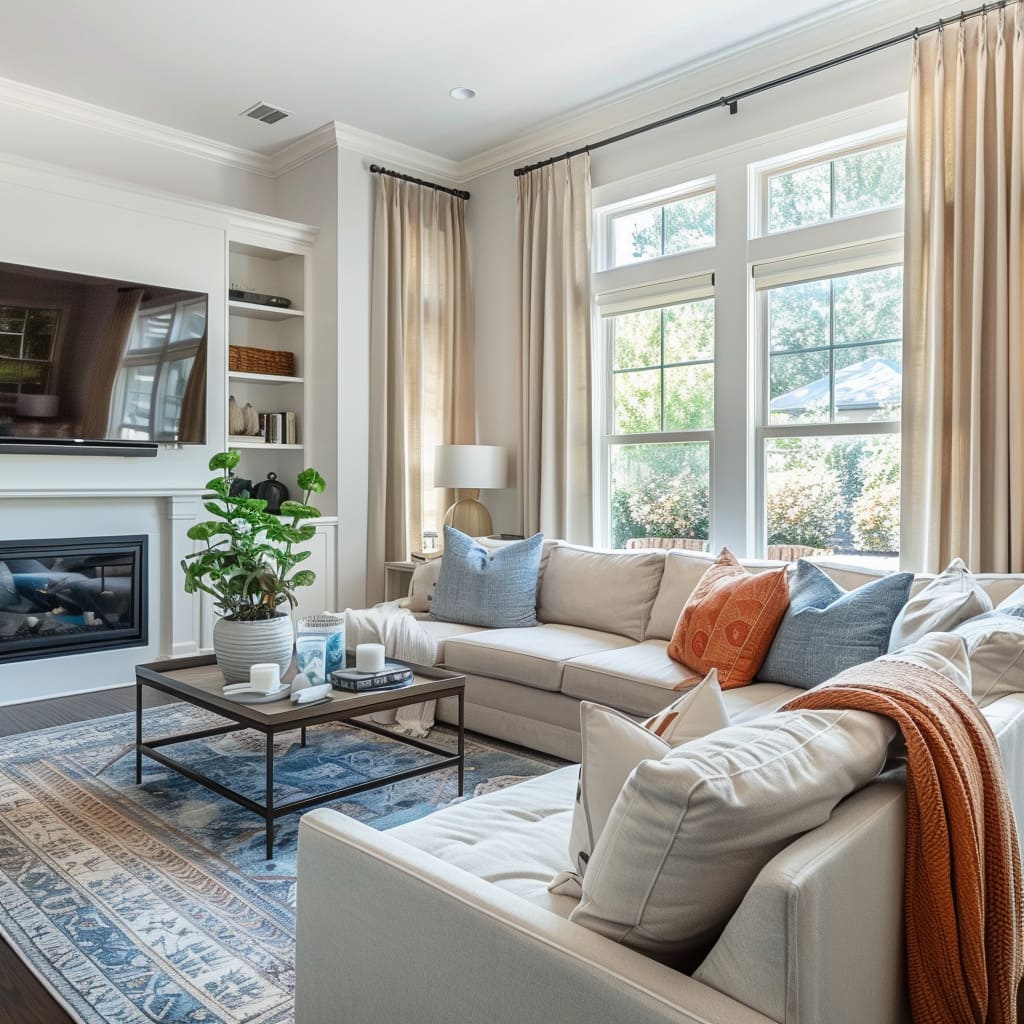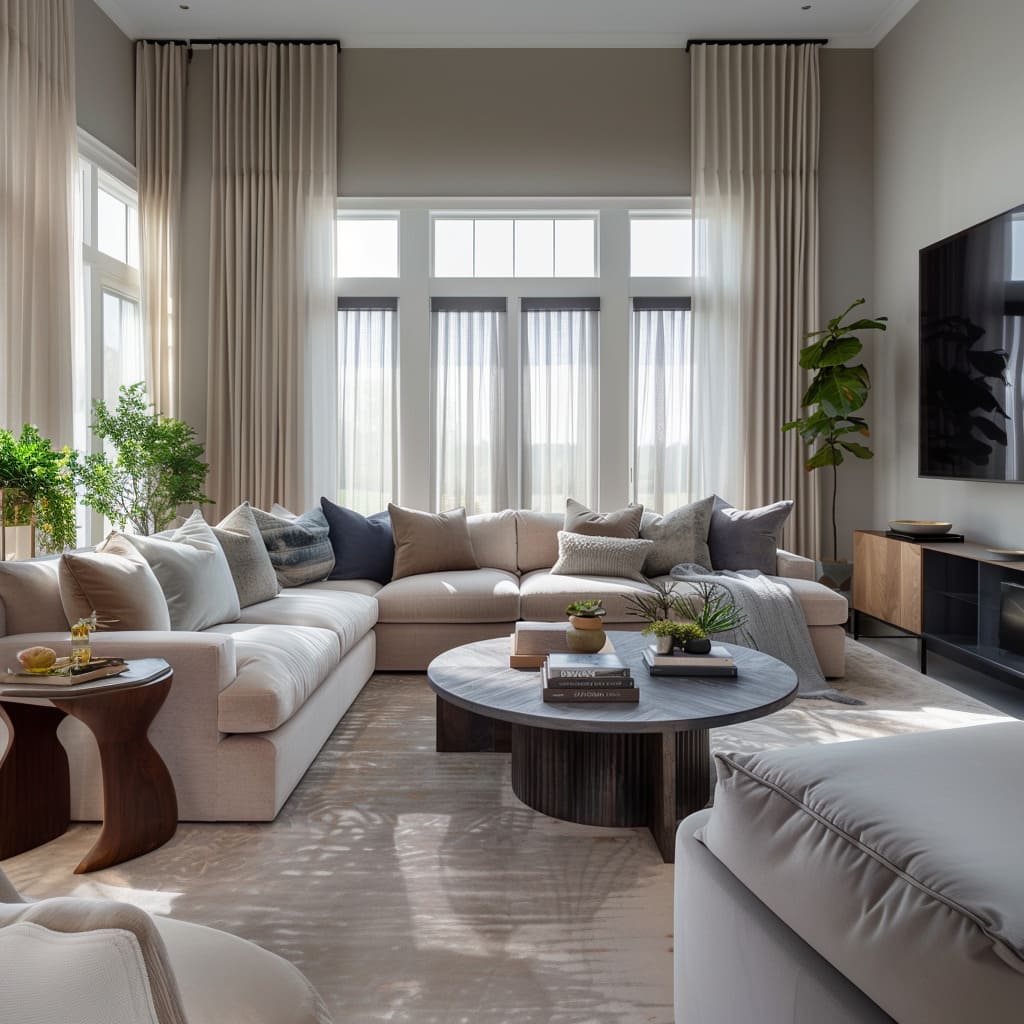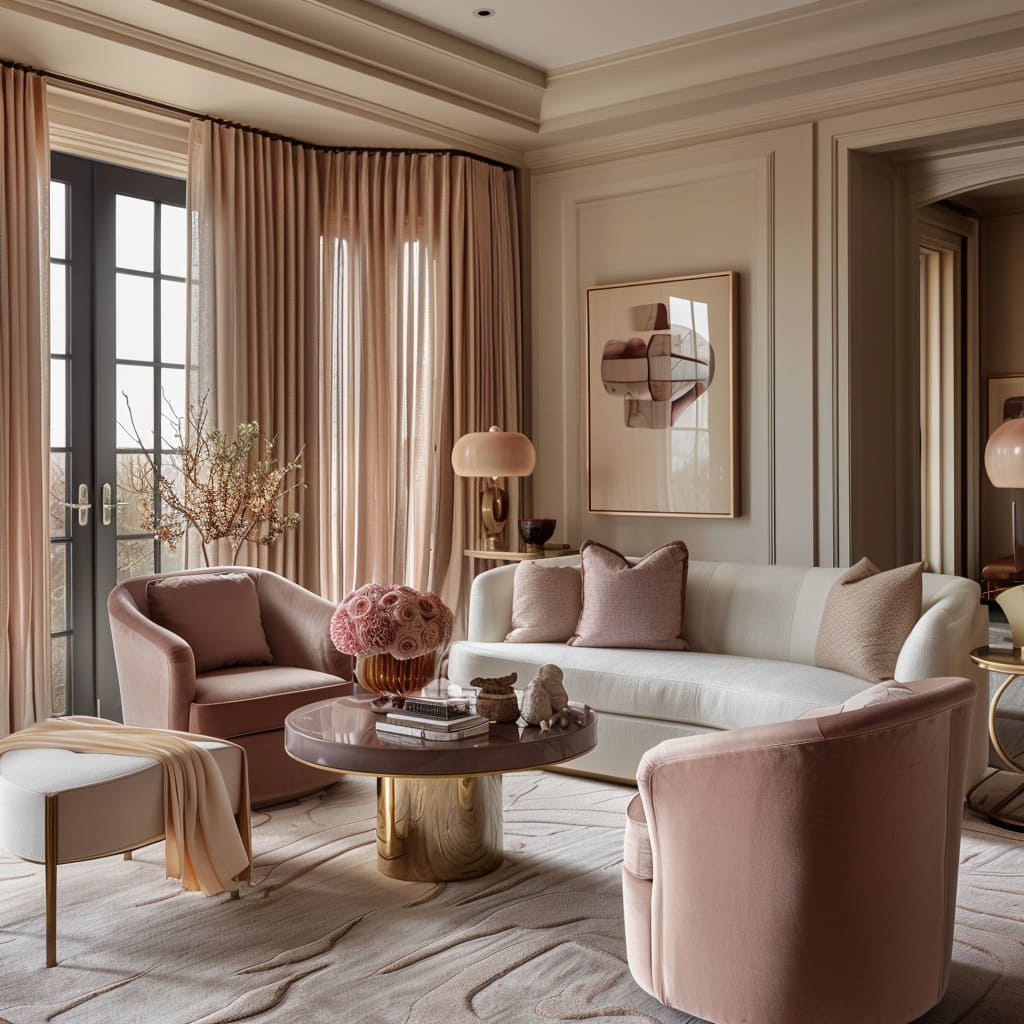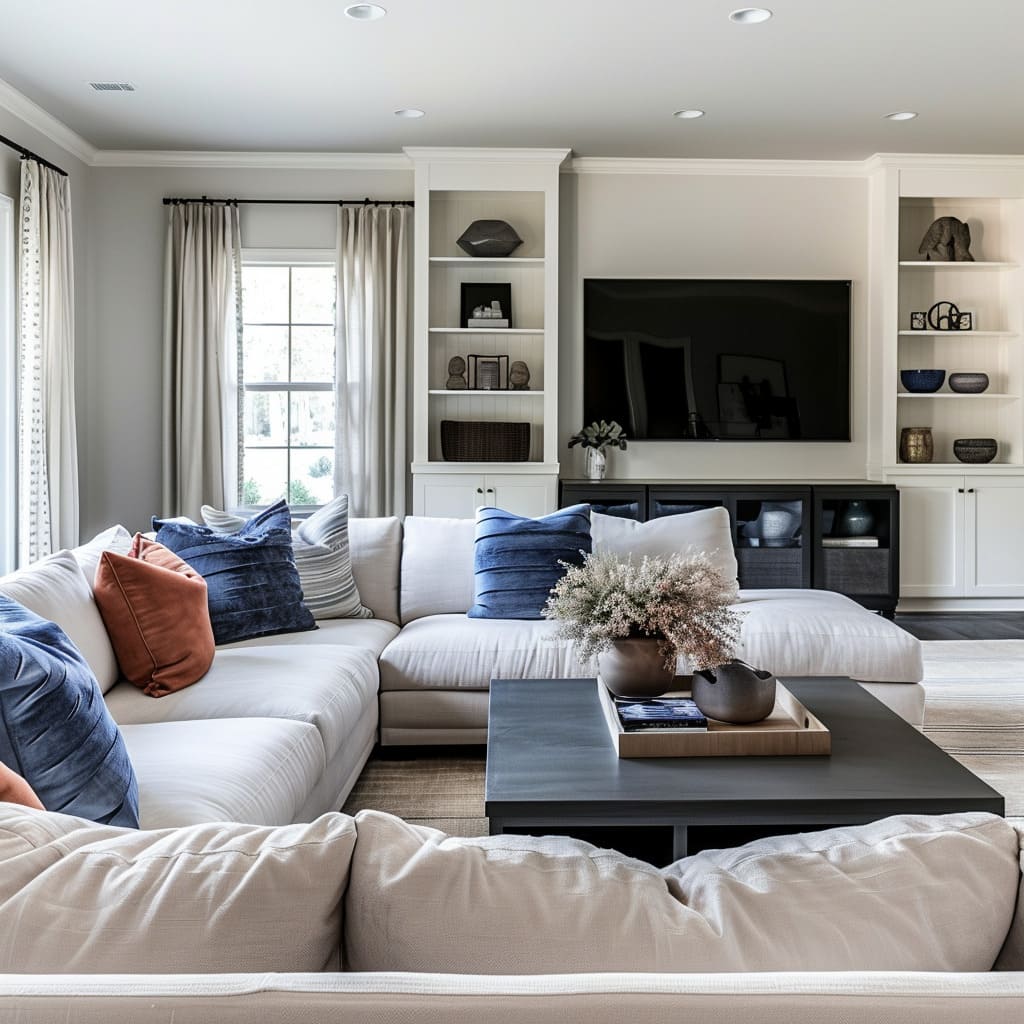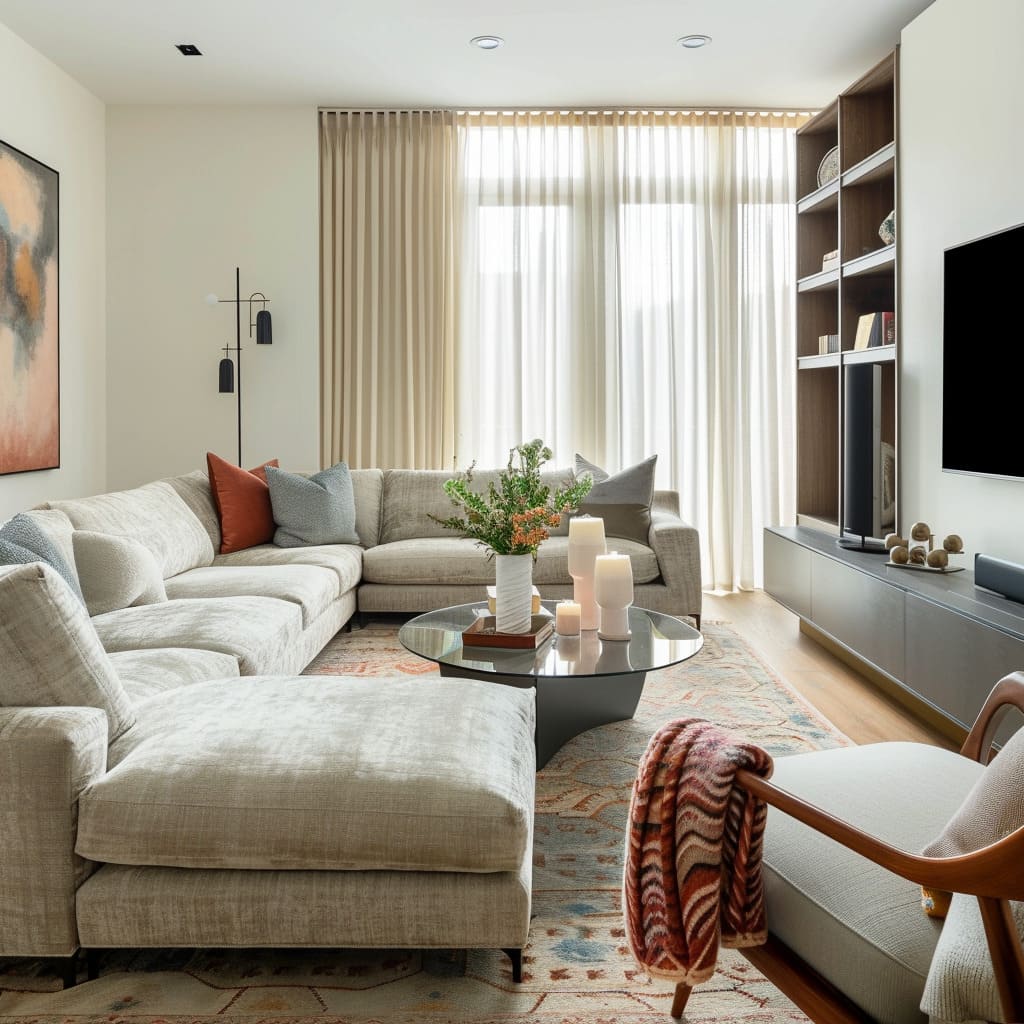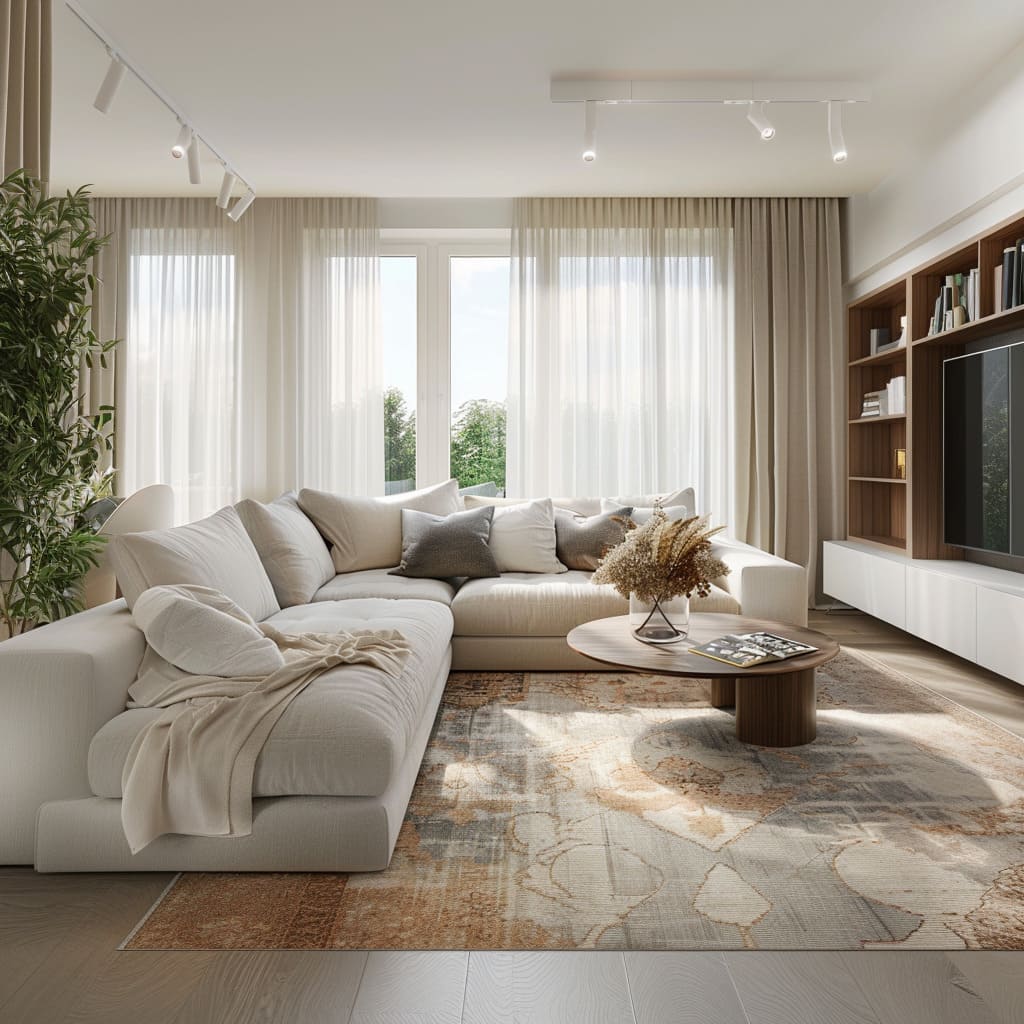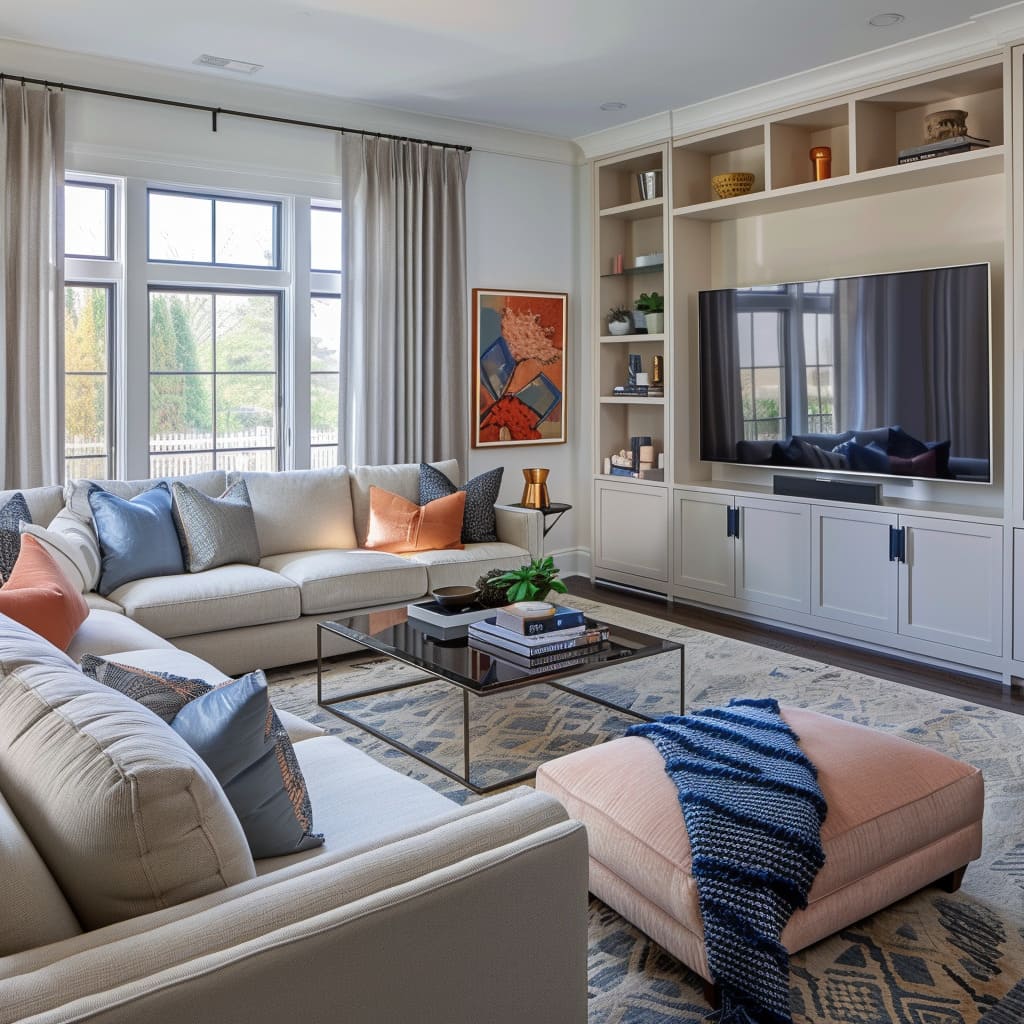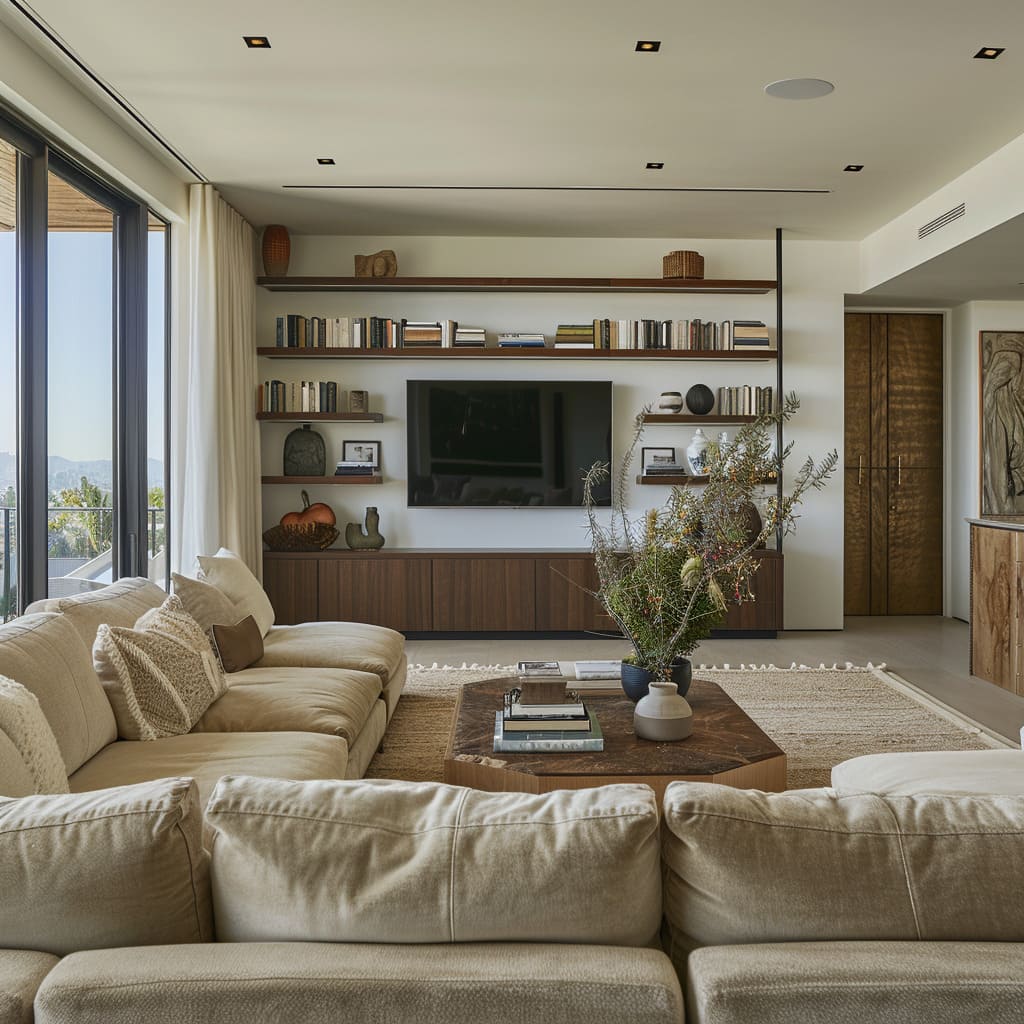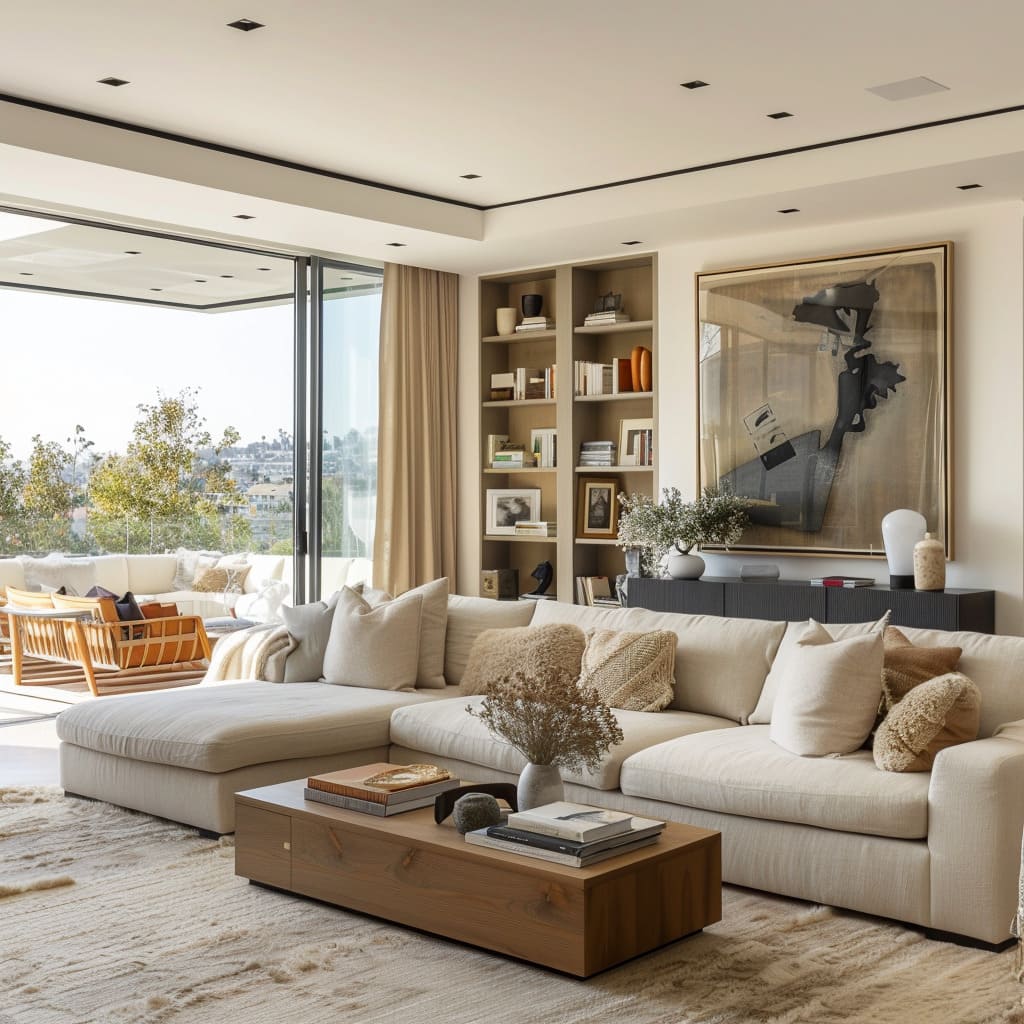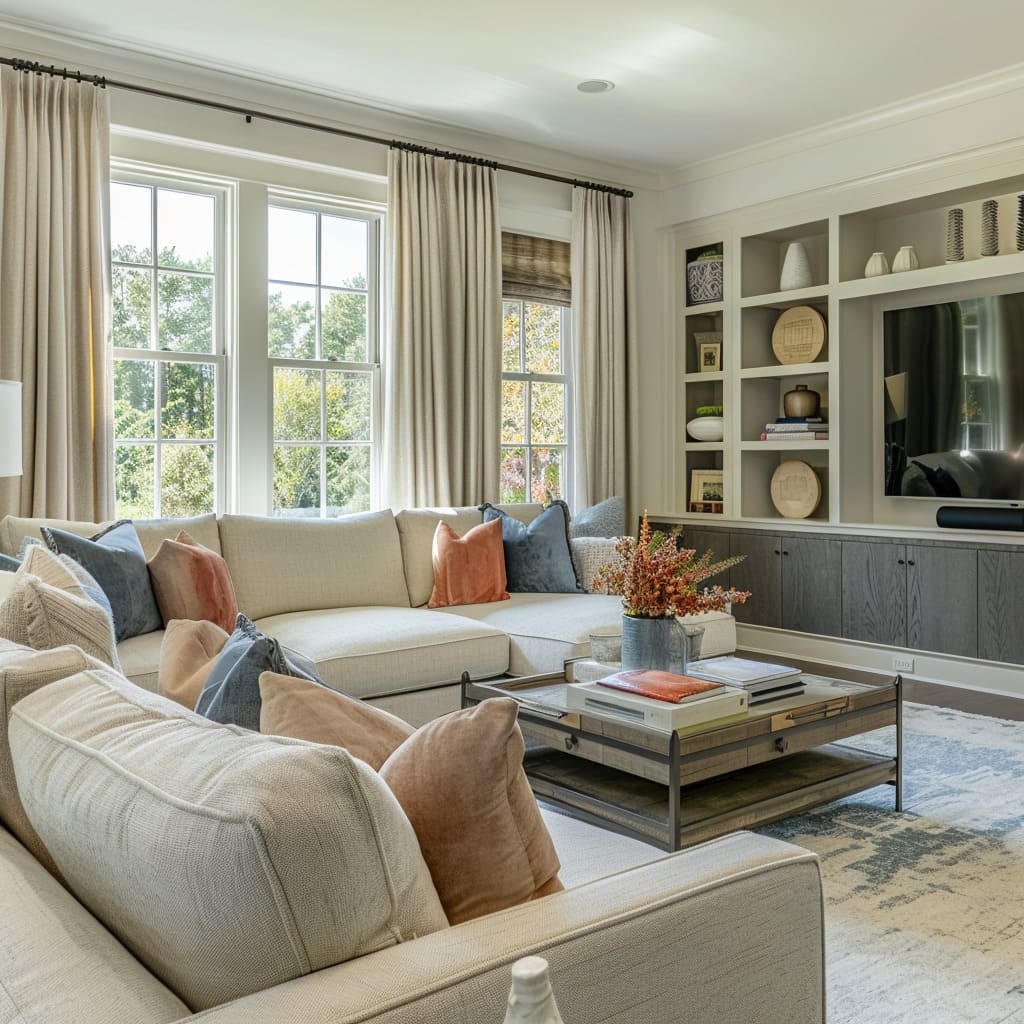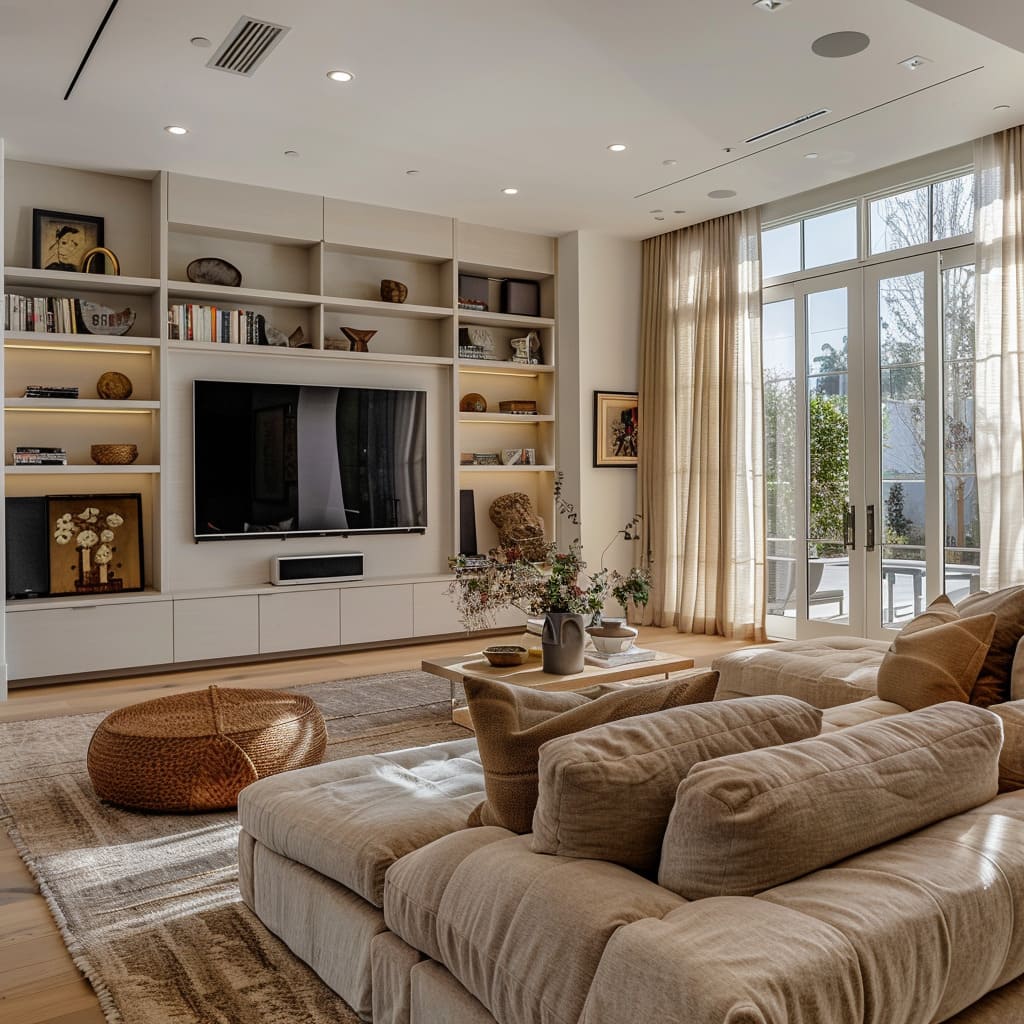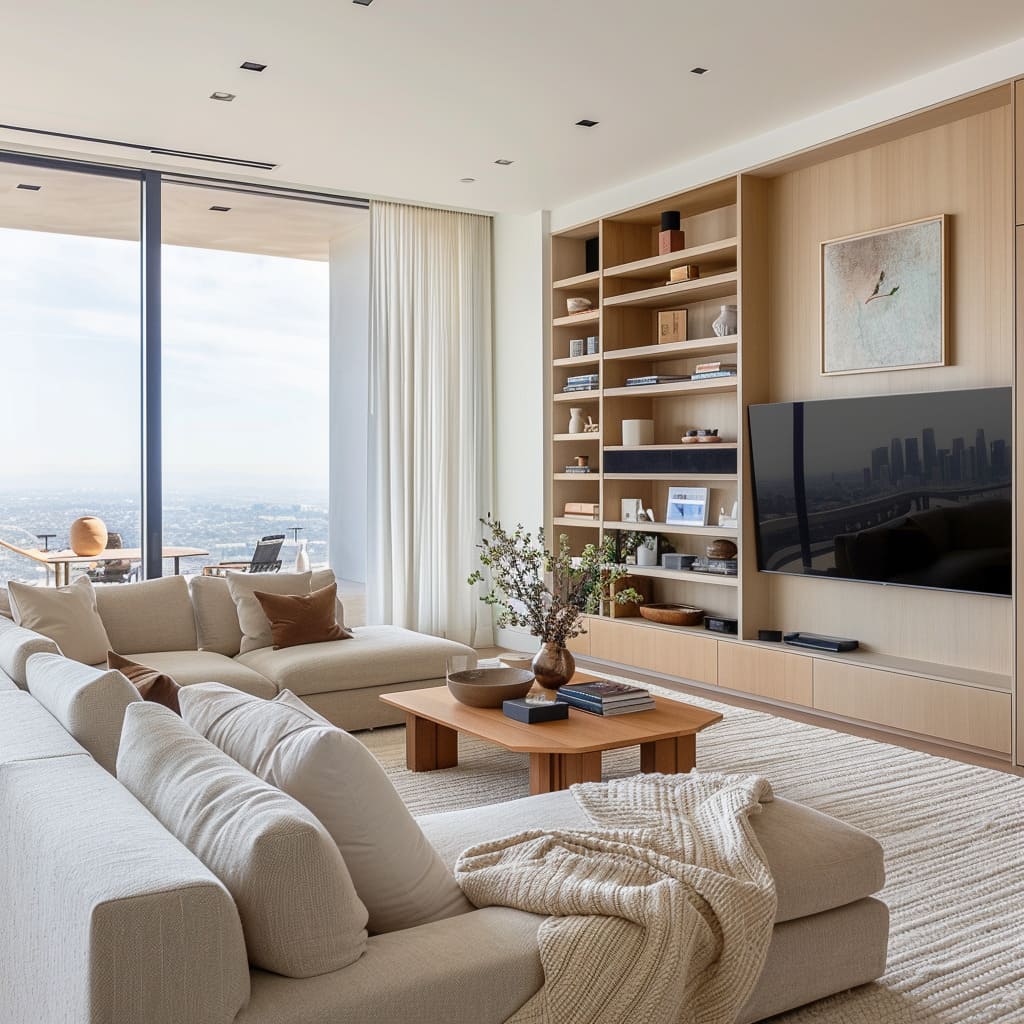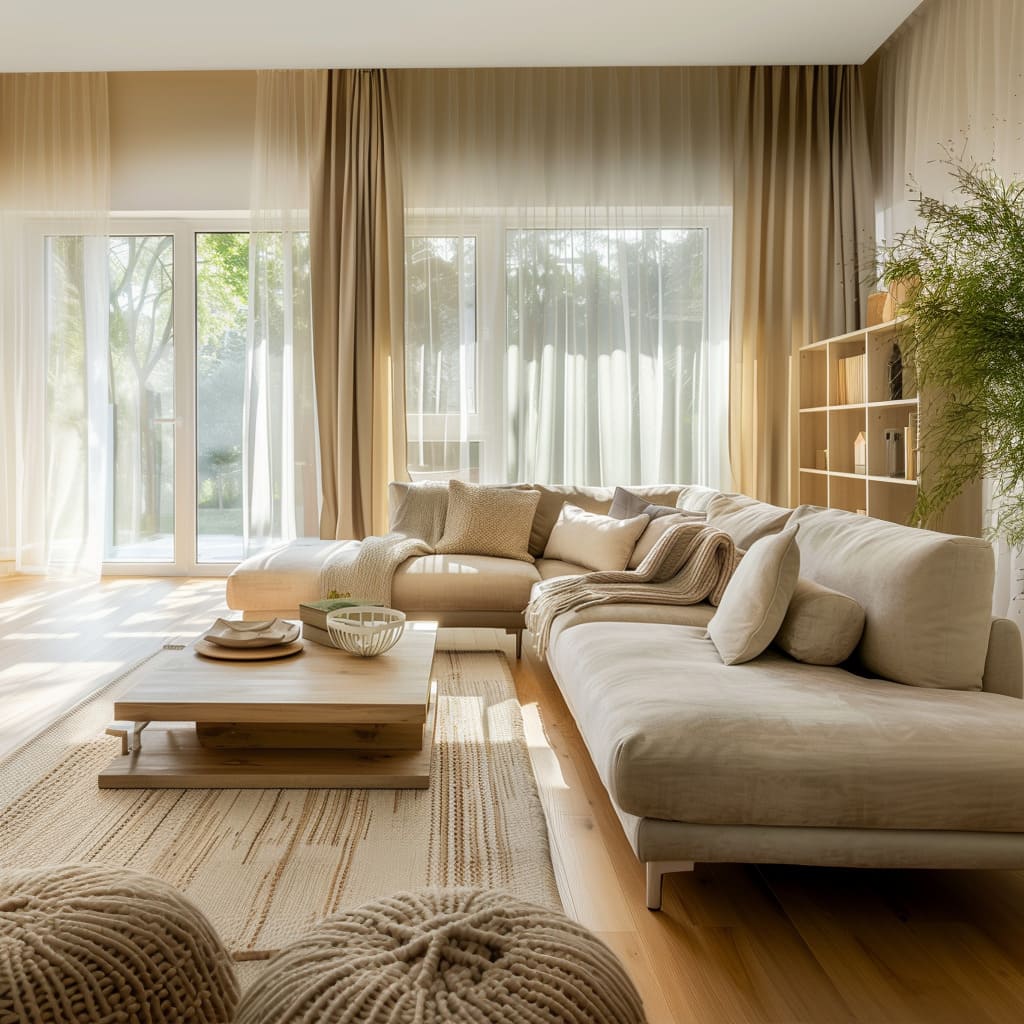In a home, the living room holds a unique place—a versatile sanctuary where design and functionality converge to create a space for retreat, entertainment, and socialization. The myriad characteristics that compose its design are not arbitrary; each serves a purpose, contributing to an atmosphere that is both inviting and expressive.
This article explores the multifaceted aspects of living room design, delving into how elements of color, light, furnishings, natural connections, materials, personal touches, and modern technology can be orchestrated to create not just a room, but a living experience. We look at how these characteristics don’t just fill a space, but how they transform it into a realm of comfort and style, and why these particular features resonate so profoundly with both our need for aesthetic pleasure and functional living.
Color and Light: Brightening Spaces with Strategic Choices
The interplay of color and light plays a pivotal role in setting the tone for a living room, simultaneously brightening spaces and creating a welcoming atmosphere. By focusing on selective use of color for focal points and accent cushions for a touch of vibrancy, designers introduce splashes of brightness that draw the eye and invigorate the room.
Recessed ceiling lights and pendant lights add layers of illumination that accentuate space and contribute to the ambiance. Execution of color blocking in accessories further adds depth and interest to the living area.
Color and illumination are essential in defining the ambiance and mood of a living room. The choice of focal colors at specific points creates visual landmarks that guide the gaze and add character.
These vibrant bursts can be found in accent cushions, bringing a lively essence to the furniture they adorn. They are not just mere fillers; their hues and textures contribute to a space that feels alive and dynamic.
Recessed ceiling lights, skillfully placed, ensure the room feels expansive and open. These fixtures blend seamlessly into the ceiling, their glow drawing attention to the room’s height and breadth without overwhelming the senses.
They provide a gentle wash of light that can make the area feel larger and more inviting. Pendant lights serve not just for practical luminance but also as sculptural pieces that add an atmospheric glow.
These fixtures act as jewelry for the ceiling, introducing a different layer of light and becoming a central part of the room’s aesthetic. The play of light and shadow they cast can add depth and drama to the area.
Lastly, the deliberate execution of color blocking in accessories creates a lively dialogue within the space. This technique brings an organized yet vibrant quality to the room, breaking the monotony and bringing an artistic, modern touch to the space.
These carefully chosen accessories become points of interest and conversation, enhancing the room’s overall appeal. Each of these elements collaborates to produce an environment that is not merely brightened but transformed into a dynamic canvas that welcomes inhabitants and guests alike.
The strategic use of light and color elevates the standard living room into a gallery of personal expression and aesthetic harmony.
Social and Functional Furnishings: Crafting Interaction and Utility
Furniture arrangement is essential in crafting a space that encourages interaction while remaining highly functional. The strategic placement of seating for social interaction invites conversation, while varied seating styles provide visual interest and accommodate different preferences.
Placement of tables as central features and the selection of coffee tables as functional centerpieces ensure that the furniture is not only aesthetically pleasing but also serves the practical needs of the space.
Furniture is not just a component of design but a catalyst for connection and practicality. Seating arranged to foster conversation invites individuals to gather and share moments, creating an atmosphere where social interactions are the heart of the space.
Such placements encourage eye contact and open dialogue, subtly steering the room’s energy toward communal engagement.
Diversity in seating styles addresses the aesthetic variety and ensures adaptability to various activities, from lounging with a book to engaging in lively discussions. Each piece is chosen not just for comfort but also to stimulate visual interest, with contrasts in form and texture that add dynamism to the living space.
This variety also provides a versatile setting that caters to the varied preferences of guests, allowing everyone to find their own comfortable nook.
Tables within these living spaces do more than fill a space; they act as pivotal features around which daily life revolves. Their strategic placement is intended to draw people into the room, offering a place for everything from decorative objects to evening refreshments.
They are the silent anchors that provide stability to the flow of the room.
Coffee tables, specifically selected for their functionality, become the hub of activity. They’re not just surfaces for resting a cup or a magazine but are central to the living area’s utility.
Their height, surface area, and placement are thoughtfully considered to complement the seating, ensuring that everything one might need is within reach, contributing to an unforced and intuitive living experience. In combining these elements, the living room is transformed into an inviting sphere where aesthetics meet function.
Here, each piece of furniture is more than a solitary element; together they create a symphony of design that makes daily living both effortless and visually stimulating. This harmonious blend of practicality and design sophistication ensures that the living room is not only a space to look at but a place to live in.
Natural and Artistic Expressions: Infusing Personality and Outdoor Harmony
A living room comes alive with elements that reflect the inhabitants’ personalities and the natural world outside. The use of large windows for outdoor views and the incorporation of glass to enhance spaciousness establishes a connection with the environment.
Wall art as focal points and the display of pottery and vases as decor elements allow for personal expression and bring an artistic flair to the room. The infusion of nature and artistry in a living room can transform a conventional space into a sanctuary of personal expression and connection to the outdoors.
Large windows act as canvases that capture the dynamic artwork of nature, presenting shifting views that range from the gentle sway of tree branches to the expansive sky. These windows do more than offer a glimpse outside; they bridge the gap between interior comfort and the beauty of the outside world, allowing for a visual continuity that enhances the sense of space.
Art, in its many forms, is strategically positioned within the room to serve as anchors of creativity and culture. Wall art becomes more than decoration; it reflects the passions and tastes of the inhabitants, offering a silent but potent narrative of who they are.
The art selected often converses with the design elements around it, creating a cohesive visual story that is both sophisticated and introspective. The inclusion of glass in furniture or decor amplifies the openness of a space, leveraging transparency to make rooms appear more extensive and uninterrupted.
This material’s reflective quality adds a layer of depth and a modern touch that can make spaces seem airier and more fluid. Glass tables or ornaments catch light and reflections, becoming living pieces that change appearance throughout the day.
Pottery and vases are chosen not just for their inherent beauty but also for their ability to introduce organic forms and earthy textures into the living environment. Whether they are artisanal creations or simpler forms, they add a tactile dimension that complements the visual richness of the space.
Arranged thoughtfully, these pieces can serve as understated yet potent symbols of sophistication and earth-connectedness. By harmonizing these natural and artistic elements, the living room is elevated into a realm where aesthetic appeal is intimately tied to natural beauty and personal expression.
It’s a space that invites relaxation and reflection, celebrating the innate connection between human creativity and the natural world’s effortless elegance.
Textures and Materials: Weaving Comfort and Nature
Comfort and natural aesthetics are woven into the living room through the thoughtful use of materials and textures. The utilization of drapes to soften the light, use of rugs to define spaces, and use of throws for added warmth and texture, all contribute to creating a cozy and inviting atmosphere.
Use of natural materials in furnishings grounds the design in earthy authenticity, providing a tactile and visual comfort that is both stylish and down-to-earth.
Textures and materials are pivotal in crafting a space that resonates with comfort and brings the tranquility of the natural world indoors. Drapes are not merely window coverings; they are instrumental in modulating the light and mood of a room.
By softening the daylight, they create a soothing ambiance that changes with the time of day, casting a gentle glow or providing a veil of privacy when drawn. The fabric’s flow and texture add an element of softness, mitigating the starkness of walls and windows.
Rugs delineate the purpose within a room, silently demarcating areas for relaxation or social gatherings. Their patterns and textures underfoot are a mosaic of comfort, grounding the furniture and adding a layer of warmth and sound insulation.
The rug’s placement and design are deliberate, complementing the room’s furnishings and contributing to the overall sense of cohesion. Throws, casually draped over a sofa or chair, introduce an inviting sense of warmth.
They invite occupants to wrap themselves in a cocoon of comfort, adding a tactile dimension that appeals to the need for relaxation and ease. These elements of softness in throws vary in material, from woven wool to plush fleece, each adding a different texture and warmth level.
Natural materials in furnishings bring the honesty and calming essence of the outdoors into the interior environment. Wood, stone, leather, and cotton offer a tapestry of textures that speak to the human desire for natural connections.
The grain of a wooden coffee table, the cool smoothness of a marble countertop, or the supple give of a leather armchair – each material contributes its unique touch to the symphony of sensations within a living space. Through the thoughtful application of these textures and materials, a room is transformed into a tactile experience that goes beyond the visual.
It becomes a space that appeals to our inherent connection with nature and our need for tactile, comfortable interactions. This approach to design ensures the living room is not just seen but felt, creating an immersive environment that comforts the body and soothes the mind.
Personalization and Flow: Shaping the Room with Intention
Every living room is a reflection of the individuals who inhabit the space, and personal touches make the room truly theirs. Utilization of bookshelves for personal touches enables the display of cherished items and reading materials.
Arrangement of accessories in groups for visual appeal and the alignment of furniture to create a flow in movement provide a structured yet personalized touch to the space. The configuration of spaces for both entertainment and relaxation ensures that the room meets the diverse needs of relaxation and socializing.
In the realm of interior design, personalization and the intelligent flow of space are essential for creating an environment that’s both functional and reflective of the inhabitants’ character. Bookshelves in a living area serve as more than storage; they are displays for personal artifacts, collections, and literature that reveal the interests and journeys of the dwellers.
These shelves are carefully styled, often becoming galleries showcasing everything from well-thumbed novels to treasured keepsakes, telling tales without words.
The arrangement of accessories, like artful groupings of objects, provides not only visual appeal but also personal narratives within the room. From vases clustered at varying heights to curated displays of photographs and mementos, these compositions offer insight into the homeowner’s aesthetic and life experiences.
They serve as visual vignettes, each group inviting closer inspection and contemplation.
A curated selection of reading materials, thoughtfully chosen and placed, can transform a simple table or nook into a sanctuary for the mind. These collections encourage leisurely perusal, reflecting the residents’ intellectual pursuits and interests.
The presence of books and magazines within arm’s reach encourages spontaneous moments of reading and reflection, underscoring the room’s lived-in feel. The alignment of furniture is meticulously planned to facilitate an effortless flow in movement, guiding one seamlessly from one area to another.
This careful placement allows for a natural progression through the room, ensuring that movement feels intuitive and unobstructed. Furniture is arranged to promote both interaction and individual reflection, supporting the room’s multifunctional nature.
The configuration of the living space acknowledges the need for versatility, carefully balancing zones for entertainment with those for relaxation. Areas for active engagement are equipped with comfortable seating and multimedia systems, while quieter corners are outfitted with plush chairs and ambient lighting, creating pockets of tranquility for introspection or rest.
In weaving together these aspects of personalization and flow, a living room becomes more than a space—it becomes a testament to the lives lived within its walls. It invites both movement and pause, providing the perfect backdrop for life’s quiet moments and exuberant gatherings.
Modern Integration: Embracing Convenience and Style
In an age where technology permeates every aspect of life, integrating it seamlessly into the living room enhances convenience without sacrificing style. Incorporation of modern technology seamlessly with the living space is vital for a functional yet uncluttered environment.
Window treatments to complement the design aesthetic further merge functionality with style, offering control over privacy and light with a look that complements the overall design.
In a contemporary living room, modern technology and design coalesce to create a space that is both sophisticated and user-friendly. The seamless incorporation of modern technology into the living area speaks to a lifestyle where convenience meets cutting-edge style.
Televisions, sound systems, and smart home devices are integrated so subtly that they complement rather than disrupt the aesthetic of the room. The clever concealment of wires and the strategic placement of devices ensure that the technology enhances the living experience without becoming the focal point.
Window treatments in these spaces are not mere afterthoughts but key components that resonate with the overall design scheme. They work in harmony with the room’s palette and patterns, contributing to the visual narrative without overpowering it.
Whether through the use of sheer fabrics that filter light to create a soft glow or more substantial materials that provide privacy and insulation, these treatments are essential in achieving both practicality and visual cohesion. In these thoughtfully designed living spaces, the blend of convenience and style is apparent.
Touches such as motorized blinds that retract with the touch of a button or mood lighting that adjusts via a smartphone app reflect a modern sensibility where living is made easier through technology. These technological conveniences are selected not only for their functionality but also for their ability to integrate into the design seamlessly.
Living rooms today are not just places to sit; they are command centers for the home, where the control of the environment is at the inhabitants’ fingertips. The modern living room acknowledges the fast pace of life and offers solutions that are as stylish as they are practical.
In a true testament to contemporary living, these spaces illustrate that form and function can indeed exist in a beautiful equilibrium, creating living areas that are not just attractive and comfortable but are smart and responsive to the needs of daily life.
The convergence of modern technology with classic design principles forms a living area that is both timelessly beautiful and unmistakably current. It’s a space that respects the traditions of home comfort while embracing the innovations that define modern living.
The result is a living room that is not only a pleasure to look at but also a pleasure to live in, a harmonious blend of the best of both worlds.
From the interplay of light and color to the strategic placement of furniture; from the infusion of natural beauty to the integration of personal accents and modern conveniences, the living room emerges as a space that celebrates both the art of design and the science of living. Each characteristic we’ve explored contributes to a greater whole—a living room that invites us in, encourages us to stay, and stays with us even when we leave.
It’s clear that the secret to a comfortable and attractive living room lies in the harmonious blend of its features, each selected and placed with intention and thoughtfulness. The modern living room stands as a testament to our times, encapsulating our progress and echoing our individual stories, all within the four walls of a space that continues to evolve with us, promising not only a place of comfort but a platform for life’s many moments.


